IT and Organizational Theory in Oil & Gas
VerifiedAdded on 2020/02/05
|26
|6985
|44
Literature Review
AI Summary
This assignment delves into the interplay between Information Technology (IT) and organizational theory within the context of the African oil and gas industry. It encourages students to critically examine various research papers and case studies that explore how IT advancements have potentially outpaced traditional management theories in this sector. The analysis should shed light on the implications of this dynamic for organizational structures, decision-making processes, and overall performance within the African oil and gas landscape.
Contribute Materials
Your contribution can guide someone’s learning journey. Share your
documents today.

Balanced Scorecards 1
The effects of Balanced Scorecards on Decision Makers of Management in the Oil and Gas
Industry
Student’s Name
Course Code and Name
Instructor’s Name
Institution’s Name
City State
Date of Submission
The effects of Balanced Scorecards on Decision Makers of Management in the Oil and Gas
Industry
Student’s Name
Course Code and Name
Instructor’s Name
Institution’s Name
City State
Date of Submission
Secure Best Marks with AI Grader
Need help grading? Try our AI Grader for instant feedback on your assignments.
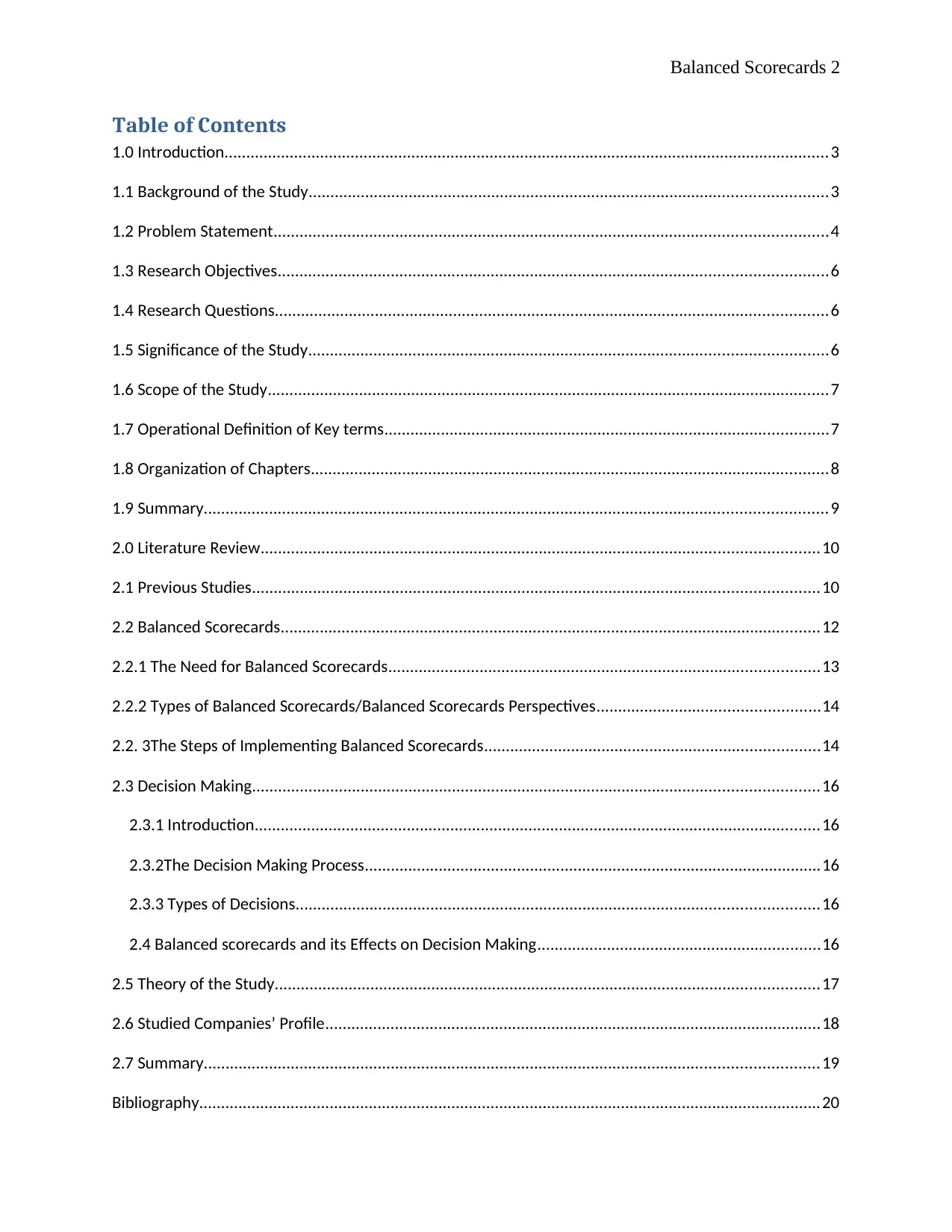
Balanced Scorecards 2
Table of Contents
1.0 Introduction...........................................................................................................................................3
1.1 Background of the Study.......................................................................................................................3
1.2 Problem Statement...............................................................................................................................4
1.3 Research Objectives..............................................................................................................................6
1.4 Research Questions...............................................................................................................................6
1.5 Significance of the Study.......................................................................................................................6
1.6 Scope of the Study.................................................................................................................................7
1.7 Operational Definition of Key terms......................................................................................................7
1.8 Organization of Chapters.......................................................................................................................8
1.9 Summary...............................................................................................................................................9
2.0 Literature Review................................................................................................................................10
2.1 Previous Studies..................................................................................................................................10
2.2 Balanced Scorecards............................................................................................................................12
2.2.1 The Need for Balanced Scorecards...................................................................................................13
2.2.2 Types of Balanced Scorecards/Balanced Scorecards Perspectives...................................................14
2.2. 3The Steps of Implementing Balanced Scorecards.............................................................................14
2.3 Decision Making..................................................................................................................................16
2.3.1 Introduction..................................................................................................................................16
2.3.2The Decision Making Process.........................................................................................................16
2.3.3 Types of Decisions........................................................................................................................16
2.4 Balanced scorecards and its Effects on Decision Making.................................................................16
2.5 Theory of the Study.............................................................................................................................17
2.6 Studied Companies’ Profile..................................................................................................................18
2.7 Summary.............................................................................................................................................19
Bibliography...............................................................................................................................................20
Table of Contents
1.0 Introduction...........................................................................................................................................3
1.1 Background of the Study.......................................................................................................................3
1.2 Problem Statement...............................................................................................................................4
1.3 Research Objectives..............................................................................................................................6
1.4 Research Questions...............................................................................................................................6
1.5 Significance of the Study.......................................................................................................................6
1.6 Scope of the Study.................................................................................................................................7
1.7 Operational Definition of Key terms......................................................................................................7
1.8 Organization of Chapters.......................................................................................................................8
1.9 Summary...............................................................................................................................................9
2.0 Literature Review................................................................................................................................10
2.1 Previous Studies..................................................................................................................................10
2.2 Balanced Scorecards............................................................................................................................12
2.2.1 The Need for Balanced Scorecards...................................................................................................13
2.2.2 Types of Balanced Scorecards/Balanced Scorecards Perspectives...................................................14
2.2. 3The Steps of Implementing Balanced Scorecards.............................................................................14
2.3 Decision Making..................................................................................................................................16
2.3.1 Introduction..................................................................................................................................16
2.3.2The Decision Making Process.........................................................................................................16
2.3.3 Types of Decisions........................................................................................................................16
2.4 Balanced scorecards and its Effects on Decision Making.................................................................16
2.5 Theory of the Study.............................................................................................................................17
2.6 Studied Companies’ Profile..................................................................................................................18
2.7 Summary.............................................................................................................................................19
Bibliography...............................................................................................................................................20
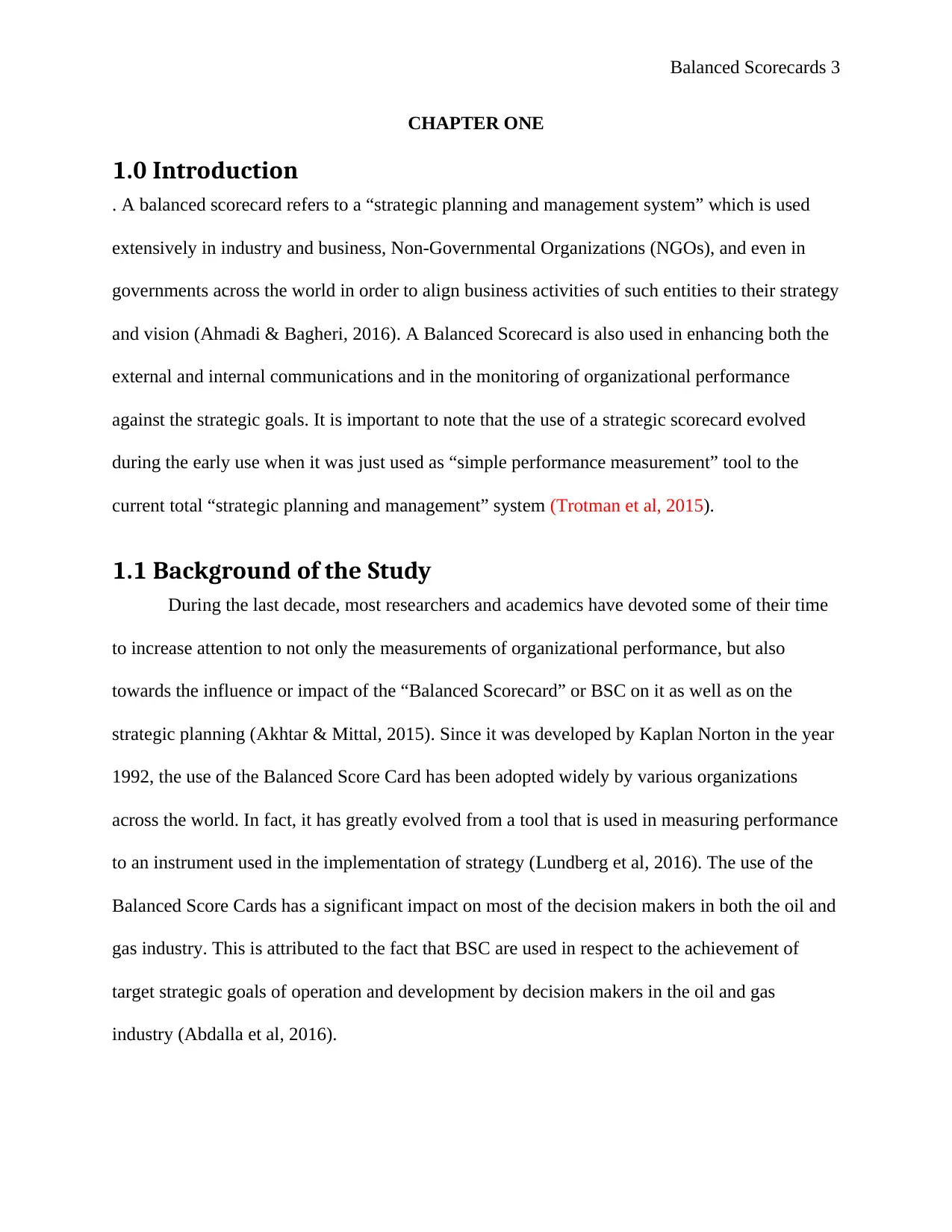
Balanced Scorecards 3
CHAPTER ONE
1.0 Introduction
. A balanced scorecard refers to a “strategic planning and management system” which is used
extensively in industry and business, Non-Governmental Organizations (NGOs), and even in
governments across the world in order to align business activities of such entities to their strategy
and vision (Ahmadi & Bagheri, 2016). A Balanced Scorecard is also used in enhancing both the
external and internal communications and in the monitoring of organizational performance
against the strategic goals. It is important to note that the use of a strategic scorecard evolved
during the early use when it was just used as “simple performance measurement” tool to the
current total “strategic planning and management” system (Trotman et al, 2015).
1.1 Background of the Study
During the last decade, most researchers and academics have devoted some of their time
to increase attention to not only the measurements of organizational performance, but also
towards the influence or impact of the “Balanced Scorecard” or BSC on it as well as on the
strategic planning (Akhtar & Mittal, 2015). Since it was developed by Kaplan Norton in the year
1992, the use of the Balanced Score Card has been adopted widely by various organizations
across the world. In fact, it has greatly evolved from a tool that is used in measuring performance
to an instrument used in the implementation of strategy (Lundberg et al, 2016). The use of the
Balanced Score Cards has a significant impact on most of the decision makers in both the oil and
gas industry. This is attributed to the fact that BSC are used in respect to the achievement of
target strategic goals of operation and development by decision makers in the oil and gas
industry (Abdalla et al, 2016).
CHAPTER ONE
1.0 Introduction
. A balanced scorecard refers to a “strategic planning and management system” which is used
extensively in industry and business, Non-Governmental Organizations (NGOs), and even in
governments across the world in order to align business activities of such entities to their strategy
and vision (Ahmadi & Bagheri, 2016). A Balanced Scorecard is also used in enhancing both the
external and internal communications and in the monitoring of organizational performance
against the strategic goals. It is important to note that the use of a strategic scorecard evolved
during the early use when it was just used as “simple performance measurement” tool to the
current total “strategic planning and management” system (Trotman et al, 2015).
1.1 Background of the Study
During the last decade, most researchers and academics have devoted some of their time
to increase attention to not only the measurements of organizational performance, but also
towards the influence or impact of the “Balanced Scorecard” or BSC on it as well as on the
strategic planning (Akhtar & Mittal, 2015). Since it was developed by Kaplan Norton in the year
1992, the use of the Balanced Score Card has been adopted widely by various organizations
across the world. In fact, it has greatly evolved from a tool that is used in measuring performance
to an instrument used in the implementation of strategy (Lundberg et al, 2016). The use of the
Balanced Score Cards has a significant impact on most of the decision makers in both the oil and
gas industry. This is attributed to the fact that BSC are used in respect to the achievement of
target strategic goals of operation and development by decision makers in the oil and gas
industry (Abdalla et al, 2016).
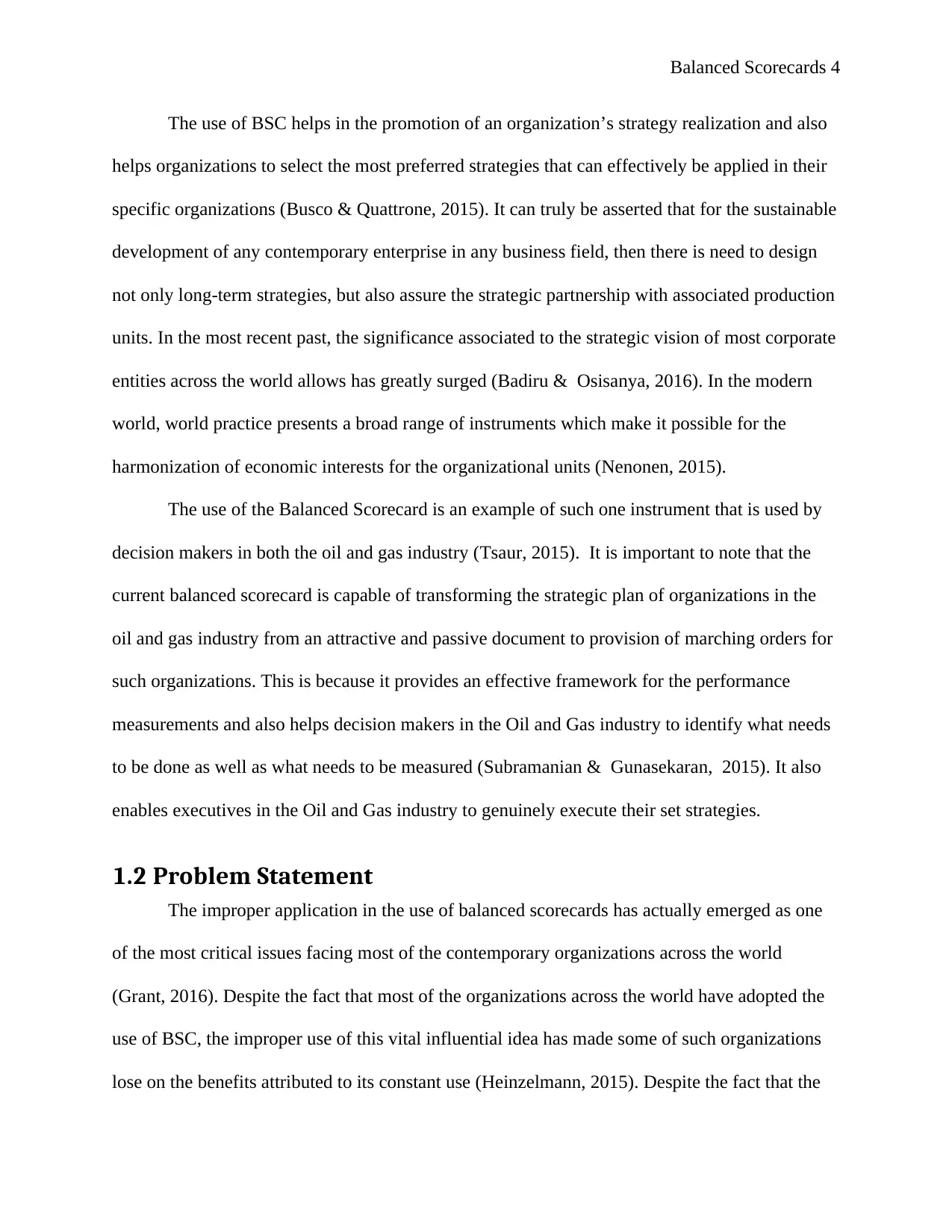
Balanced Scorecards 4
The use of BSC helps in the promotion of an organization’s strategy realization and also
helps organizations to select the most preferred strategies that can effectively be applied in their
specific organizations (Busco & Quattrone, 2015). It can truly be asserted that for the sustainable
development of any contemporary enterprise in any business field, then there is need to design
not only long-term strategies, but also assure the strategic partnership with associated production
units. In the most recent past, the significance associated to the strategic vision of most corporate
entities across the world allows has greatly surged (Badiru & Osisanya, 2016). In the modern
world, world practice presents a broad range of instruments which make it possible for the
harmonization of economic interests for the organizational units (Nenonen, 2015).
The use of the Balanced Scorecard is an example of such one instrument that is used by
decision makers in both the oil and gas industry (Tsaur, 2015). It is important to note that the
current balanced scorecard is capable of transforming the strategic plan of organizations in the
oil and gas industry from an attractive and passive document to provision of marching orders for
such organizations. This is because it provides an effective framework for the performance
measurements and also helps decision makers in the Oil and Gas industry to identify what needs
to be done as well as what needs to be measured (Subramanian & Gunasekaran, 2015). It also
enables executives in the Oil and Gas industry to genuinely execute their set strategies.
1.2 Problem Statement
The improper application in the use of balanced scorecards has actually emerged as one
of the most critical issues facing most of the contemporary organizations across the world
(Grant, 2016). Despite the fact that most of the organizations across the world have adopted the
use of BSC, the improper use of this vital influential idea has made some of such organizations
lose on the benefits attributed to its constant use (Heinzelmann, 2015). Despite the fact that the
The use of BSC helps in the promotion of an organization’s strategy realization and also
helps organizations to select the most preferred strategies that can effectively be applied in their
specific organizations (Busco & Quattrone, 2015). It can truly be asserted that for the sustainable
development of any contemporary enterprise in any business field, then there is need to design
not only long-term strategies, but also assure the strategic partnership with associated production
units. In the most recent past, the significance associated to the strategic vision of most corporate
entities across the world allows has greatly surged (Badiru & Osisanya, 2016). In the modern
world, world practice presents a broad range of instruments which make it possible for the
harmonization of economic interests for the organizational units (Nenonen, 2015).
The use of the Balanced Scorecard is an example of such one instrument that is used by
decision makers in both the oil and gas industry (Tsaur, 2015). It is important to note that the
current balanced scorecard is capable of transforming the strategic plan of organizations in the
oil and gas industry from an attractive and passive document to provision of marching orders for
such organizations. This is because it provides an effective framework for the performance
measurements and also helps decision makers in the Oil and Gas industry to identify what needs
to be done as well as what needs to be measured (Subramanian & Gunasekaran, 2015). It also
enables executives in the Oil and Gas industry to genuinely execute their set strategies.
1.2 Problem Statement
The improper application in the use of balanced scorecards has actually emerged as one
of the most critical issues facing most of the contemporary organizations across the world
(Grant, 2016). Despite the fact that most of the organizations across the world have adopted the
use of BSC, the improper use of this vital influential idea has made some of such organizations
lose on the benefits attributed to its constant use (Heinzelmann, 2015). Despite the fact that the
Secure Best Marks with AI Grader
Need help grading? Try our AI Grader for instant feedback on your assignments.
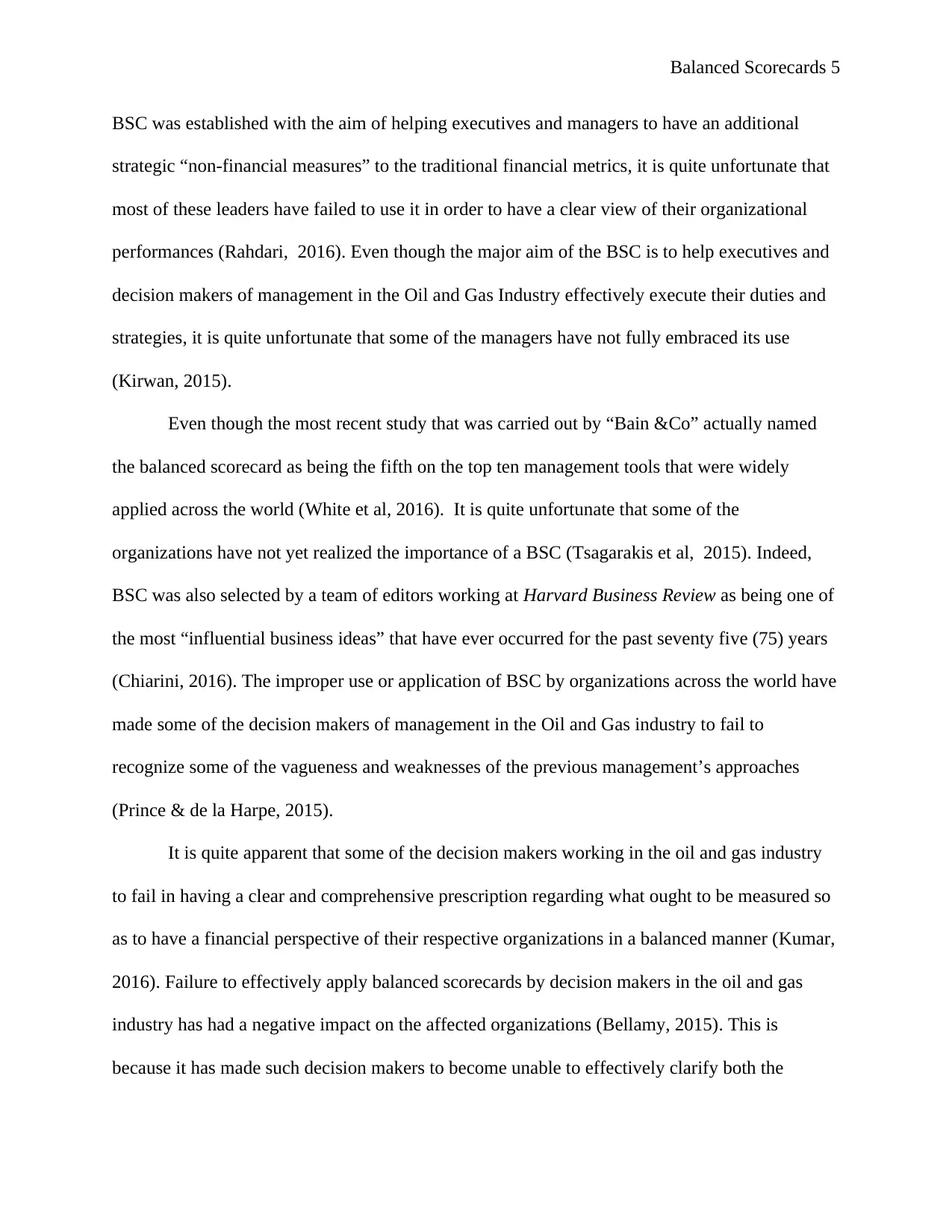
Balanced Scorecards 5
BSC was established with the aim of helping executives and managers to have an additional
strategic “non-financial measures” to the traditional financial metrics, it is quite unfortunate that
most of these leaders have failed to use it in order to have a clear view of their organizational
performances (Rahdari, 2016). Even though the major aim of the BSC is to help executives and
decision makers of management in the Oil and Gas Industry effectively execute their duties and
strategies, it is quite unfortunate that some of the managers have not fully embraced its use
(Kirwan, 2015).
Even though the most recent study that was carried out by “Bain &Co” actually named
the balanced scorecard as being the fifth on the top ten management tools that were widely
applied across the world (White et al, 2016). It is quite unfortunate that some of the
organizations have not yet realized the importance of a BSC (Tsagarakis et al, 2015). Indeed,
BSC was also selected by a team of editors working at Harvard Business Review as being one of
the most “influential business ideas” that have ever occurred for the past seventy five (75) years
(Chiarini, 2016). The improper use or application of BSC by organizations across the world have
made some of the decision makers of management in the Oil and Gas industry to fail to
recognize some of the vagueness and weaknesses of the previous management’s approaches
(Prince & de la Harpe, 2015).
It is quite apparent that some of the decision makers working in the oil and gas industry
to fail in having a clear and comprehensive prescription regarding what ought to be measured so
as to have a financial perspective of their respective organizations in a balanced manner (Kumar,
2016). Failure to effectively apply balanced scorecards by decision makers in the oil and gas
industry has had a negative impact on the affected organizations (Bellamy, 2015). This is
because it has made such decision makers to become unable to effectively clarify both the
BSC was established with the aim of helping executives and managers to have an additional
strategic “non-financial measures” to the traditional financial metrics, it is quite unfortunate that
most of these leaders have failed to use it in order to have a clear view of their organizational
performances (Rahdari, 2016). Even though the major aim of the BSC is to help executives and
decision makers of management in the Oil and Gas Industry effectively execute their duties and
strategies, it is quite unfortunate that some of the managers have not fully embraced its use
(Kirwan, 2015).
Even though the most recent study that was carried out by “Bain &Co” actually named
the balanced scorecard as being the fifth on the top ten management tools that were widely
applied across the world (White et al, 2016). It is quite unfortunate that some of the
organizations have not yet realized the importance of a BSC (Tsagarakis et al, 2015). Indeed,
BSC was also selected by a team of editors working at Harvard Business Review as being one of
the most “influential business ideas” that have ever occurred for the past seventy five (75) years
(Chiarini, 2016). The improper use or application of BSC by organizations across the world have
made some of the decision makers of management in the Oil and Gas industry to fail to
recognize some of the vagueness and weaknesses of the previous management’s approaches
(Prince & de la Harpe, 2015).
It is quite apparent that some of the decision makers working in the oil and gas industry
to fail in having a clear and comprehensive prescription regarding what ought to be measured so
as to have a financial perspective of their respective organizations in a balanced manner (Kumar,
2016). Failure to effectively apply balanced scorecards by decision makers in the oil and gas
industry has had a negative impact on the affected organizations (Bellamy, 2015). This is
because it has made such decision makers to become unable to effectively clarify both the
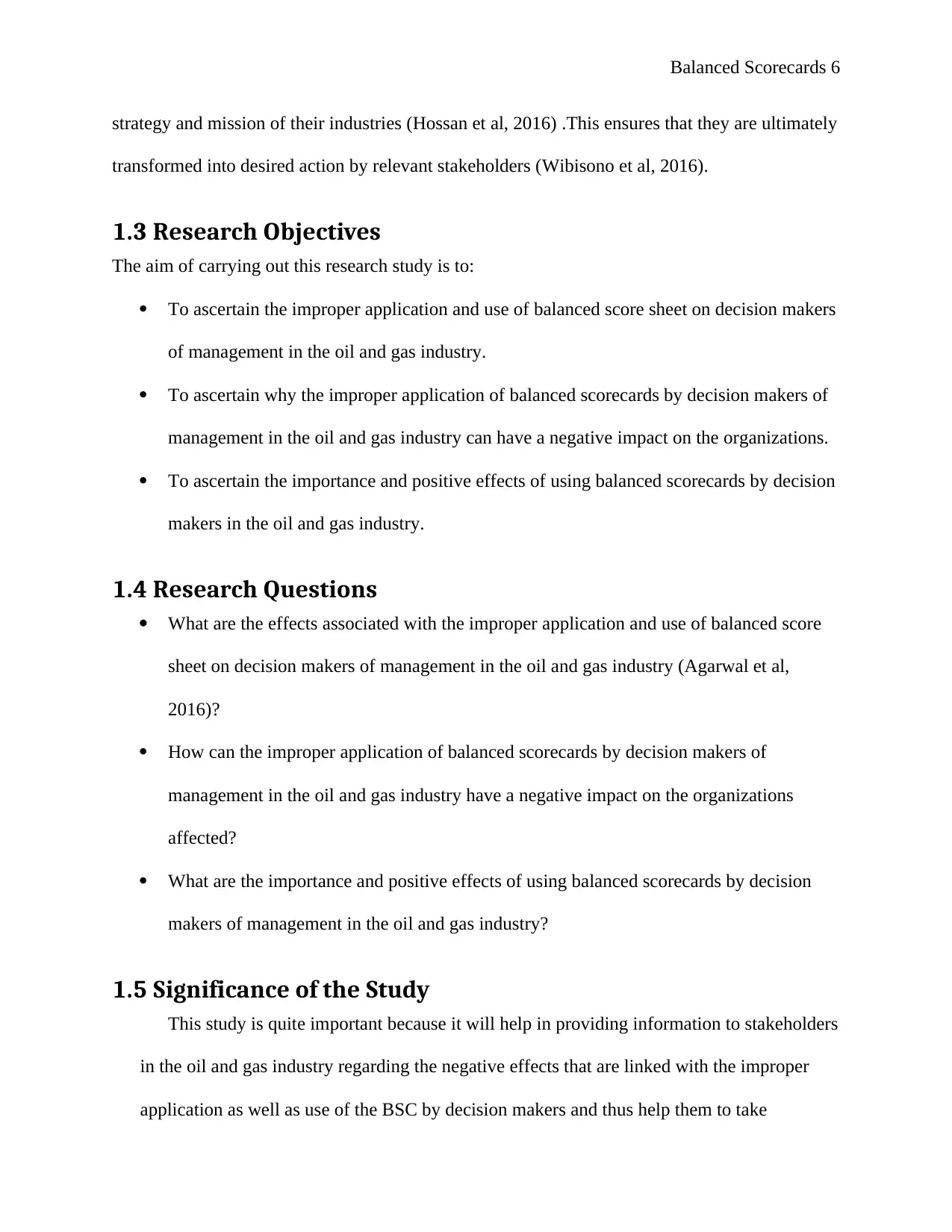
Balanced Scorecards 6
strategy and mission of their industries (Hossan et al, 2016) .This ensures that they are ultimately
transformed into desired action by relevant stakeholders (Wibisono et al, 2016).
1.3 Research Objectives
The aim of carrying out this research study is to:
To ascertain the improper application and use of balanced score sheet on decision makers
of management in the oil and gas industry.
To ascertain why the improper application of balanced scorecards by decision makers of
management in the oil and gas industry can have a negative impact on the organizations.
To ascertain the importance and positive effects of using balanced scorecards by decision
makers in the oil and gas industry.
1.4 Research Questions
What are the effects associated with the improper application and use of balanced score
sheet on decision makers of management in the oil and gas industry (Agarwal et al,
2016)?
How can the improper application of balanced scorecards by decision makers of
management in the oil and gas industry have a negative impact on the organizations
affected?
What are the importance and positive effects of using balanced scorecards by decision
makers of management in the oil and gas industry?
1.5 Significance of the Study
This study is quite important because it will help in providing information to stakeholders
in the oil and gas industry regarding the negative effects that are linked with the improper
application as well as use of the BSC by decision makers and thus help them to take
strategy and mission of their industries (Hossan et al, 2016) .This ensures that they are ultimately
transformed into desired action by relevant stakeholders (Wibisono et al, 2016).
1.3 Research Objectives
The aim of carrying out this research study is to:
To ascertain the improper application and use of balanced score sheet on decision makers
of management in the oil and gas industry.
To ascertain why the improper application of balanced scorecards by decision makers of
management in the oil and gas industry can have a negative impact on the organizations.
To ascertain the importance and positive effects of using balanced scorecards by decision
makers in the oil and gas industry.
1.4 Research Questions
What are the effects associated with the improper application and use of balanced score
sheet on decision makers of management in the oil and gas industry (Agarwal et al,
2016)?
How can the improper application of balanced scorecards by decision makers of
management in the oil and gas industry have a negative impact on the organizations
affected?
What are the importance and positive effects of using balanced scorecards by decision
makers of management in the oil and gas industry?
1.5 Significance of the Study
This study is quite important because it will help in providing information to stakeholders
in the oil and gas industry regarding the negative effects that are linked with the improper
application as well as use of the BSC by decision makers and thus help them to take
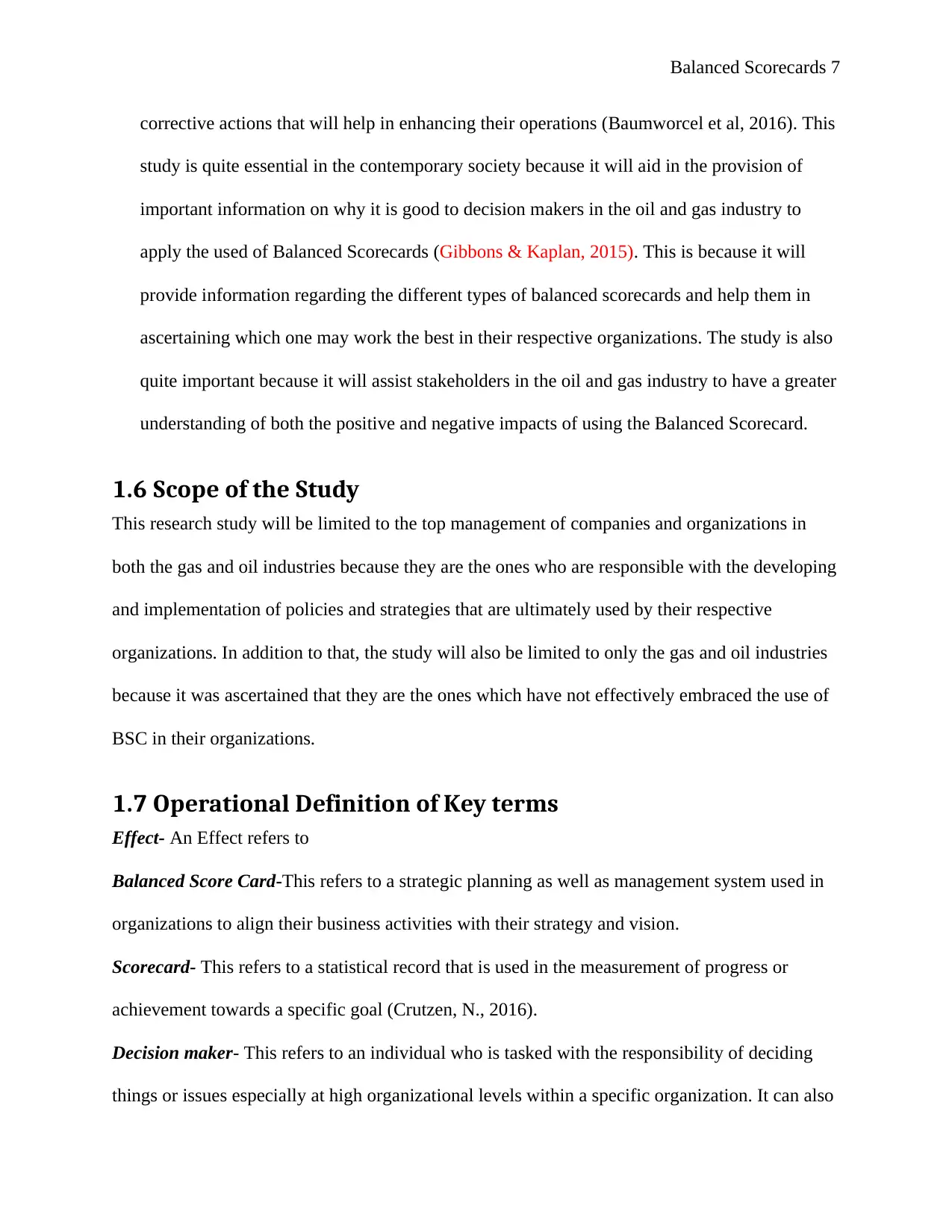
Balanced Scorecards 7
corrective actions that will help in enhancing their operations (Baumworcel et al, 2016). This
study is quite essential in the contemporary society because it will aid in the provision of
important information on why it is good to decision makers in the oil and gas industry to
apply the used of Balanced Scorecards (Gibbons & Kaplan, 2015). This is because it will
provide information regarding the different types of balanced scorecards and help them in
ascertaining which one may work the best in their respective organizations. The study is also
quite important because it will assist stakeholders in the oil and gas industry to have a greater
understanding of both the positive and negative impacts of using the Balanced Scorecard.
1.6 Scope of the Study
This research study will be limited to the top management of companies and organizations in
both the gas and oil industries because they are the ones who are responsible with the developing
and implementation of policies and strategies that are ultimately used by their respective
organizations. In addition to that, the study will also be limited to only the gas and oil industries
because it was ascertained that they are the ones which have not effectively embraced the use of
BSC in their organizations.
1.7 Operational Definition of Key terms
Effect- An Effect refers to
Balanced Score Card-This refers to a strategic planning as well as management system used in
organizations to align their business activities with their strategy and vision.
Scorecard- This refers to a statistical record that is used in the measurement of progress or
achievement towards a specific goal (Crutzen, N., 2016).
Decision maker- This refers to an individual who is tasked with the responsibility of deciding
things or issues especially at high organizational levels within a specific organization. It can also
corrective actions that will help in enhancing their operations (Baumworcel et al, 2016). This
study is quite essential in the contemporary society because it will aid in the provision of
important information on why it is good to decision makers in the oil and gas industry to
apply the used of Balanced Scorecards (Gibbons & Kaplan, 2015). This is because it will
provide information regarding the different types of balanced scorecards and help them in
ascertaining which one may work the best in their respective organizations. The study is also
quite important because it will assist stakeholders in the oil and gas industry to have a greater
understanding of both the positive and negative impacts of using the Balanced Scorecard.
1.6 Scope of the Study
This research study will be limited to the top management of companies and organizations in
both the gas and oil industries because they are the ones who are responsible with the developing
and implementation of policies and strategies that are ultimately used by their respective
organizations. In addition to that, the study will also be limited to only the gas and oil industries
because it was ascertained that they are the ones which have not effectively embraced the use of
BSC in their organizations.
1.7 Operational Definition of Key terms
Effect- An Effect refers to
Balanced Score Card-This refers to a strategic planning as well as management system used in
organizations to align their business activities with their strategy and vision.
Scorecard- This refers to a statistical record that is used in the measurement of progress or
achievement towards a specific goal (Crutzen, N., 2016).
Decision maker- This refers to an individual who is tasked with the responsibility of deciding
things or issues especially at high organizational levels within a specific organization. It can also
Paraphrase This Document
Need a fresh take? Get an instant paraphrase of this document with our AI Paraphraser
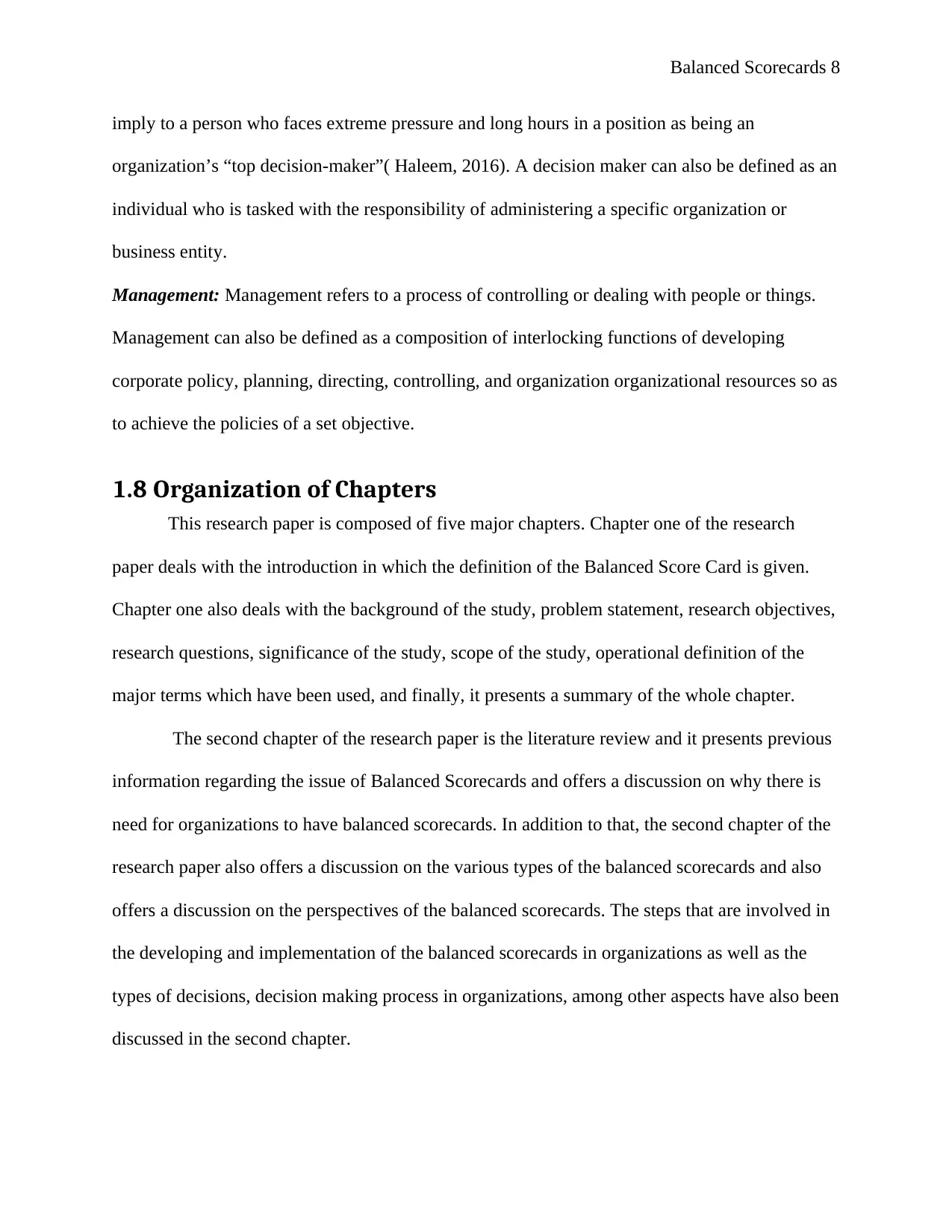
Balanced Scorecards 8
imply to a person who faces extreme pressure and long hours in a position as being an
organization’s “top decision-maker”( Haleem, 2016). A decision maker can also be defined as an
individual who is tasked with the responsibility of administering a specific organization or
business entity.
Management: Management refers to a process of controlling or dealing with people or things.
Management can also be defined as a composition of interlocking functions of developing
corporate policy, planning, directing, controlling, and organization organizational resources so as
to achieve the policies of a set objective.
1.8 Organization of Chapters
This research paper is composed of five major chapters. Chapter one of the research
paper deals with the introduction in which the definition of the Balanced Score Card is given.
Chapter one also deals with the background of the study, problem statement, research objectives,
research questions, significance of the study, scope of the study, operational definition of the
major terms which have been used, and finally, it presents a summary of the whole chapter.
The second chapter of the research paper is the literature review and it presents previous
information regarding the issue of Balanced Scorecards and offers a discussion on why there is
need for organizations to have balanced scorecards. In addition to that, the second chapter of the
research paper also offers a discussion on the various types of the balanced scorecards and also
offers a discussion on the perspectives of the balanced scorecards. The steps that are involved in
the developing and implementation of the balanced scorecards in organizations as well as the
types of decisions, decision making process in organizations, among other aspects have also been
discussed in the second chapter.
imply to a person who faces extreme pressure and long hours in a position as being an
organization’s “top decision-maker”( Haleem, 2016). A decision maker can also be defined as an
individual who is tasked with the responsibility of administering a specific organization or
business entity.
Management: Management refers to a process of controlling or dealing with people or things.
Management can also be defined as a composition of interlocking functions of developing
corporate policy, planning, directing, controlling, and organization organizational resources so as
to achieve the policies of a set objective.
1.8 Organization of Chapters
This research paper is composed of five major chapters. Chapter one of the research
paper deals with the introduction in which the definition of the Balanced Score Card is given.
Chapter one also deals with the background of the study, problem statement, research objectives,
research questions, significance of the study, scope of the study, operational definition of the
major terms which have been used, and finally, it presents a summary of the whole chapter.
The second chapter of the research paper is the literature review and it presents previous
information regarding the issue of Balanced Scorecards and offers a discussion on why there is
need for organizations to have balanced scorecards. In addition to that, the second chapter of the
research paper also offers a discussion on the various types of the balanced scorecards and also
offers a discussion on the perspectives of the balanced scorecards. The steps that are involved in
the developing and implementation of the balanced scorecards in organizations as well as the
types of decisions, decision making process in organizations, among other aspects have also been
discussed in the second chapter.
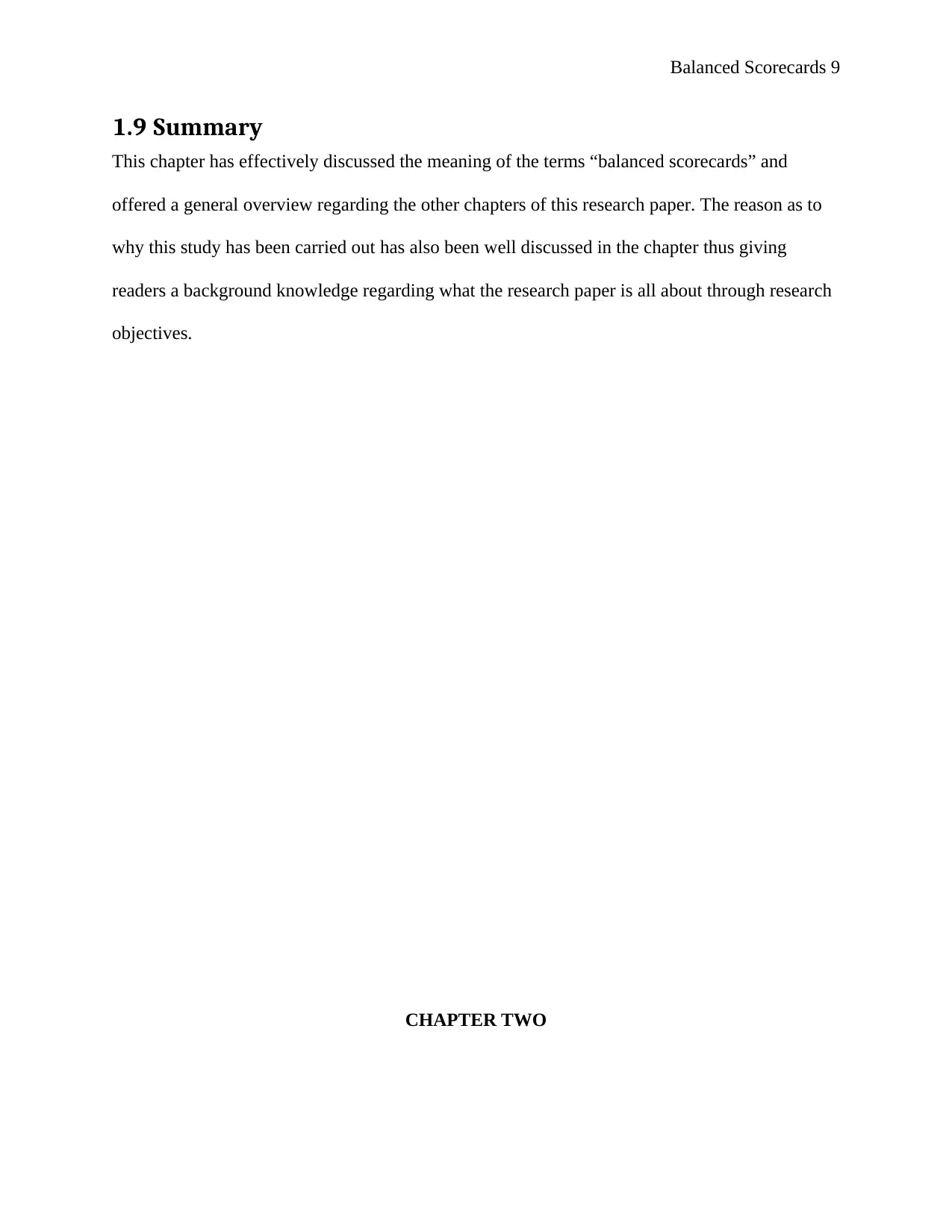
Balanced Scorecards 9
1.9 Summary
This chapter has effectively discussed the meaning of the terms “balanced scorecards” and
offered a general overview regarding the other chapters of this research paper. The reason as to
why this study has been carried out has also been well discussed in the chapter thus giving
readers a background knowledge regarding what the research paper is all about through research
objectives.
CHAPTER TWO
1.9 Summary
This chapter has effectively discussed the meaning of the terms “balanced scorecards” and
offered a general overview regarding the other chapters of this research paper. The reason as to
why this study has been carried out has also been well discussed in the chapter thus giving
readers a background knowledge regarding what the research paper is all about through research
objectives.
CHAPTER TWO
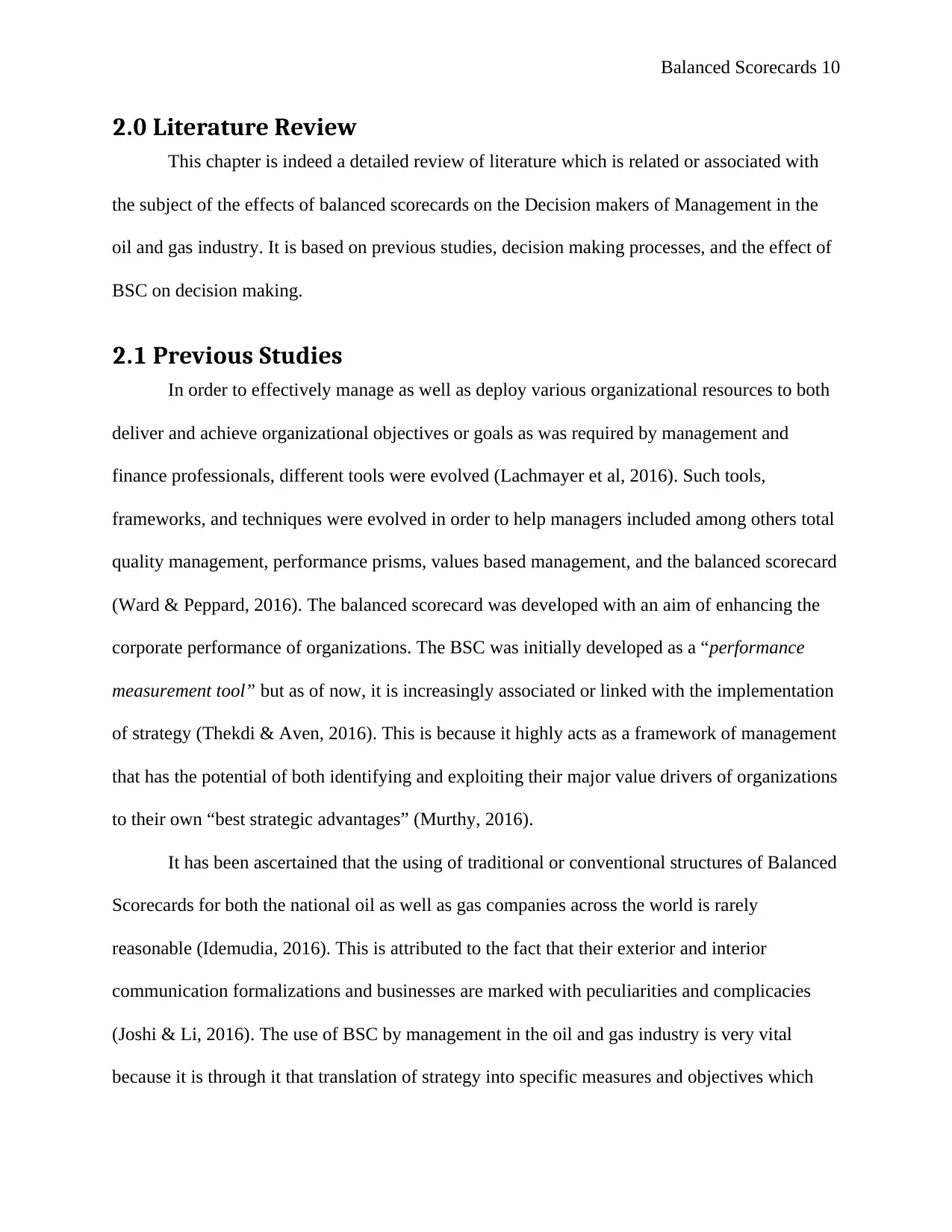
Balanced Scorecards 10
2.0 Literature Review
This chapter is indeed a detailed review of literature which is related or associated with
the subject of the effects of balanced scorecards on the Decision makers of Management in the
oil and gas industry. It is based on previous studies, decision making processes, and the effect of
BSC on decision making.
2.1 Previous Studies
In order to effectively manage as well as deploy various organizational resources to both
deliver and achieve organizational objectives or goals as was required by management and
finance professionals, different tools were evolved (Lachmayer et al, 2016). Such tools,
frameworks, and techniques were evolved in order to help managers included among others total
quality management, performance prisms, values based management, and the balanced scorecard
(Ward & Peppard, 2016). The balanced scorecard was developed with an aim of enhancing the
corporate performance of organizations. The BSC was initially developed as a “performance
measurement tool” but as of now, it is increasingly associated or linked with the implementation
of strategy (Thekdi & Aven, 2016). This is because it highly acts as a framework of management
that has the potential of both identifying and exploiting their major value drivers of organizations
to their own “best strategic advantages” (Murthy, 2016).
It has been ascertained that the using of traditional or conventional structures of Balanced
Scorecards for both the national oil as well as gas companies across the world is rarely
reasonable (Idemudia, 2016). This is attributed to the fact that their exterior and interior
communication formalizations and businesses are marked with peculiarities and complicacies
(Joshi & Li, 2016). The use of BSC by management in the oil and gas industry is very vital
because it is through it that translation of strategy into specific measures and objectives which
2.0 Literature Review
This chapter is indeed a detailed review of literature which is related or associated with
the subject of the effects of balanced scorecards on the Decision makers of Management in the
oil and gas industry. It is based on previous studies, decision making processes, and the effect of
BSC on decision making.
2.1 Previous Studies
In order to effectively manage as well as deploy various organizational resources to both
deliver and achieve organizational objectives or goals as was required by management and
finance professionals, different tools were evolved (Lachmayer et al, 2016). Such tools,
frameworks, and techniques were evolved in order to help managers included among others total
quality management, performance prisms, values based management, and the balanced scorecard
(Ward & Peppard, 2016). The balanced scorecard was developed with an aim of enhancing the
corporate performance of organizations. The BSC was initially developed as a “performance
measurement tool” but as of now, it is increasingly associated or linked with the implementation
of strategy (Thekdi & Aven, 2016). This is because it highly acts as a framework of management
that has the potential of both identifying and exploiting their major value drivers of organizations
to their own “best strategic advantages” (Murthy, 2016).
It has been ascertained that the using of traditional or conventional structures of Balanced
Scorecards for both the national oil as well as gas companies across the world is rarely
reasonable (Idemudia, 2016). This is attributed to the fact that their exterior and interior
communication formalizations and businesses are marked with peculiarities and complicacies
(Joshi & Li, 2016). The use of BSC by management in the oil and gas industry is very vital
because it is through it that translation of strategy into specific measures and objectives which
Secure Best Marks with AI Grader
Need help grading? Try our AI Grader for instant feedback on your assignments.
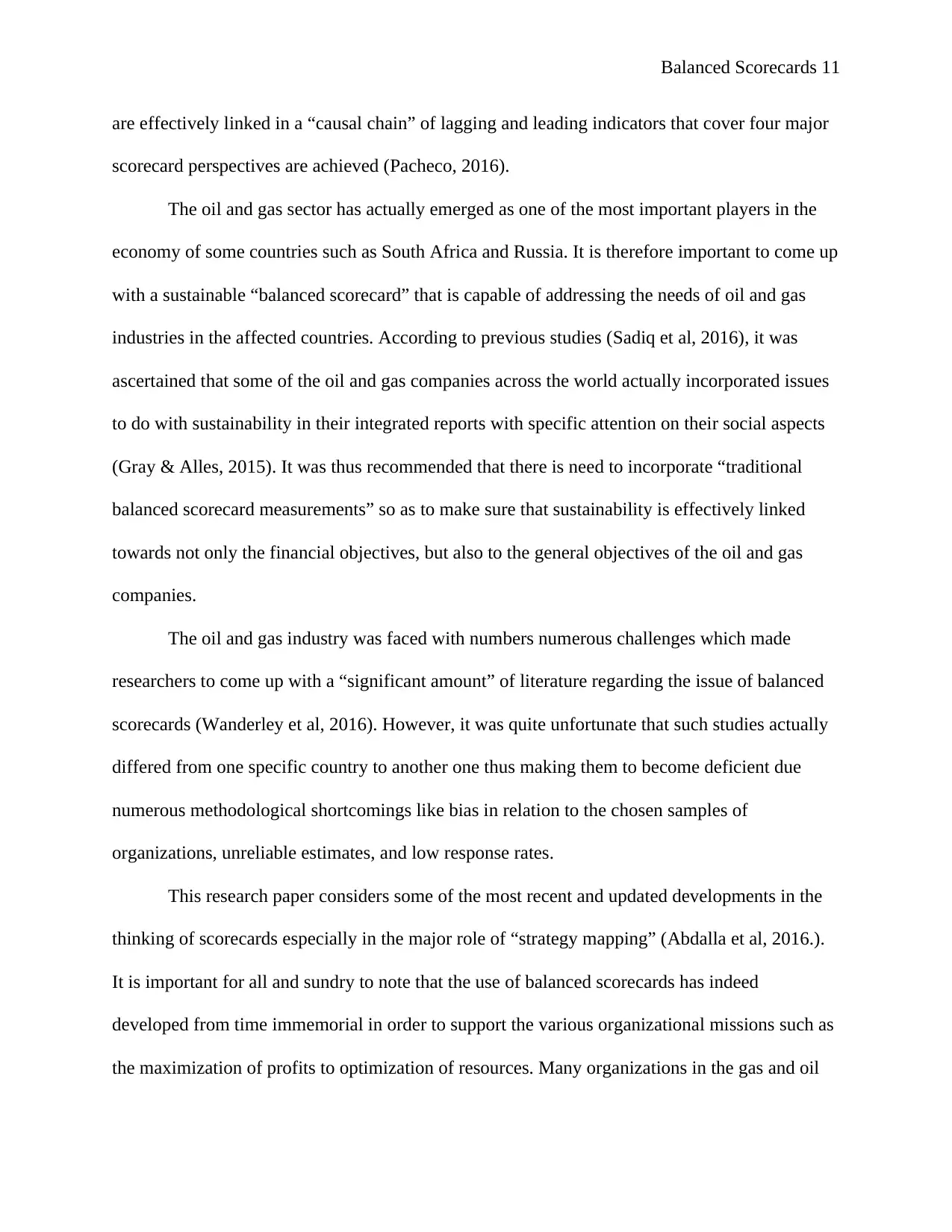
Balanced Scorecards 11
are effectively linked in a “causal chain” of lagging and leading indicators that cover four major
scorecard perspectives are achieved (Pacheco, 2016).
The oil and gas sector has actually emerged as one of the most important players in the
economy of some countries such as South Africa and Russia. It is therefore important to come up
with a sustainable “balanced scorecard” that is capable of addressing the needs of oil and gas
industries in the affected countries. According to previous studies (Sadiq et al, 2016), it was
ascertained that some of the oil and gas companies across the world actually incorporated issues
to do with sustainability in their integrated reports with specific attention on their social aspects
(Gray & Alles, 2015). It was thus recommended that there is need to incorporate “traditional
balanced scorecard measurements” so as to make sure that sustainability is effectively linked
towards not only the financial objectives, but also to the general objectives of the oil and gas
companies.
The oil and gas industry was faced with numbers numerous challenges which made
researchers to come up with a “significant amount” of literature regarding the issue of balanced
scorecards (Wanderley et al, 2016). However, it was quite unfortunate that such studies actually
differed from one specific country to another one thus making them to become deficient due
numerous methodological shortcomings like bias in relation to the chosen samples of
organizations, unreliable estimates, and low response rates.
This research paper considers some of the most recent and updated developments in the
thinking of scorecards especially in the major role of “strategy mapping” (Abdalla et al, 2016.).
It is important for all and sundry to note that the use of balanced scorecards has indeed
developed from time immemorial in order to support the various organizational missions such as
the maximization of profits to optimization of resources. Many organizations in the gas and oil
are effectively linked in a “causal chain” of lagging and leading indicators that cover four major
scorecard perspectives are achieved (Pacheco, 2016).
The oil and gas sector has actually emerged as one of the most important players in the
economy of some countries such as South Africa and Russia. It is therefore important to come up
with a sustainable “balanced scorecard” that is capable of addressing the needs of oil and gas
industries in the affected countries. According to previous studies (Sadiq et al, 2016), it was
ascertained that some of the oil and gas companies across the world actually incorporated issues
to do with sustainability in their integrated reports with specific attention on their social aspects
(Gray & Alles, 2015). It was thus recommended that there is need to incorporate “traditional
balanced scorecard measurements” so as to make sure that sustainability is effectively linked
towards not only the financial objectives, but also to the general objectives of the oil and gas
companies.
The oil and gas industry was faced with numbers numerous challenges which made
researchers to come up with a “significant amount” of literature regarding the issue of balanced
scorecards (Wanderley et al, 2016). However, it was quite unfortunate that such studies actually
differed from one specific country to another one thus making them to become deficient due
numerous methodological shortcomings like bias in relation to the chosen samples of
organizations, unreliable estimates, and low response rates.
This research paper considers some of the most recent and updated developments in the
thinking of scorecards especially in the major role of “strategy mapping” (Abdalla et al, 2016.).
It is important for all and sundry to note that the use of balanced scorecards has indeed
developed from time immemorial in order to support the various organizational missions such as
the maximization of profits to optimization of resources. Many organizations in the gas and oil
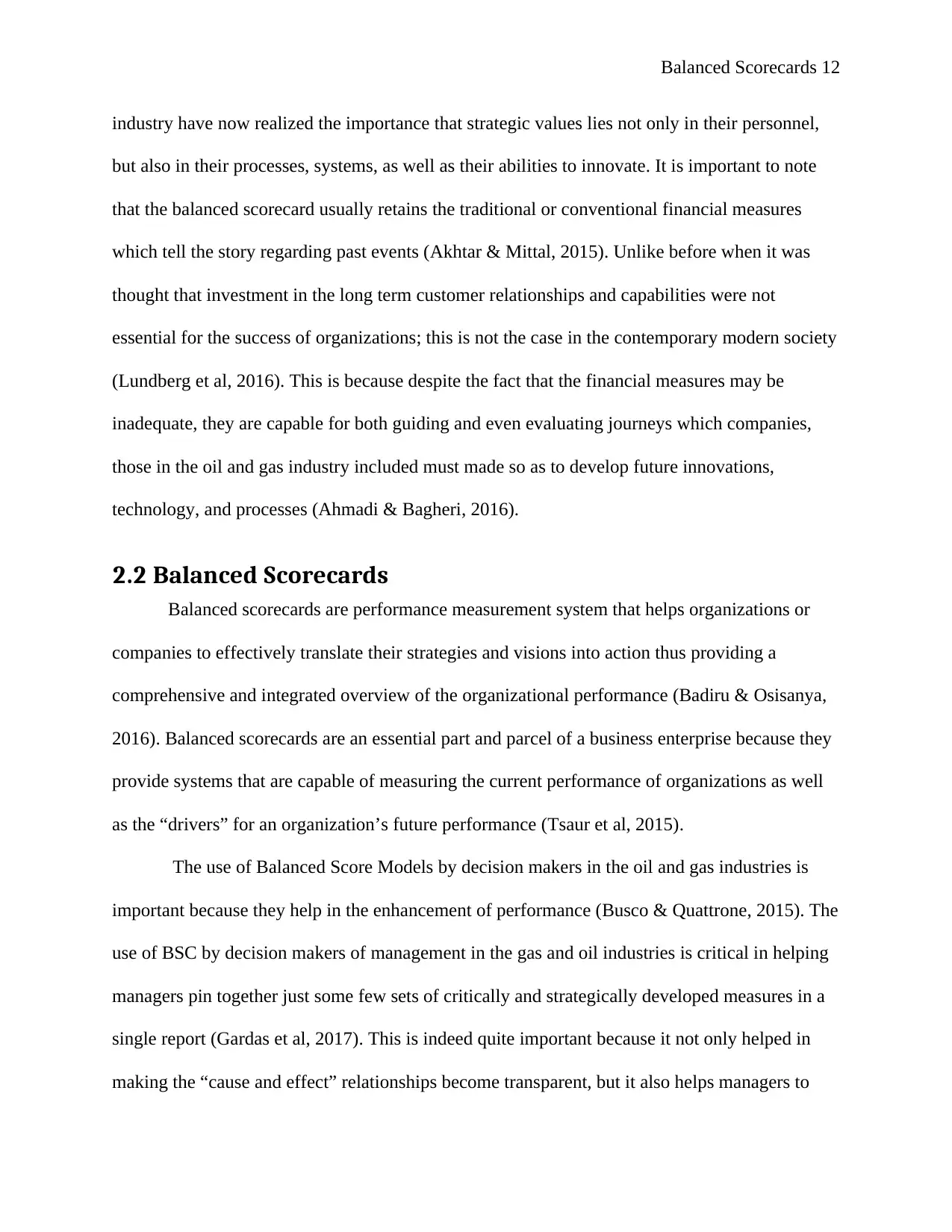
Balanced Scorecards 12
industry have now realized the importance that strategic values lies not only in their personnel,
but also in their processes, systems, as well as their abilities to innovate. It is important to note
that the balanced scorecard usually retains the traditional or conventional financial measures
which tell the story regarding past events (Akhtar & Mittal, 2015). Unlike before when it was
thought that investment in the long term customer relationships and capabilities were not
essential for the success of organizations; this is not the case in the contemporary modern society
(Lundberg et al, 2016). This is because despite the fact that the financial measures may be
inadequate, they are capable for both guiding and even evaluating journeys which companies,
those in the oil and gas industry included must made so as to develop future innovations,
technology, and processes (Ahmadi & Bagheri, 2016).
2.2 Balanced Scorecards
Balanced scorecards are performance measurement system that helps organizations or
companies to effectively translate their strategies and visions into action thus providing a
comprehensive and integrated overview of the organizational performance (Badiru & Osisanya,
2016). Balanced scorecards are an essential part and parcel of a business enterprise because they
provide systems that are capable of measuring the current performance of organizations as well
as the “drivers” for an organization’s future performance (Tsaur et al, 2015).
The use of Balanced Score Models by decision makers in the oil and gas industries is
important because they help in the enhancement of performance (Busco & Quattrone, 2015). The
use of BSC by decision makers of management in the gas and oil industries is critical in helping
managers pin together just some few sets of critically and strategically developed measures in a
single report (Gardas et al, 2017). This is indeed quite important because it not only helped in
making the “cause and effect” relationships become transparent, but it also helps managers to
industry have now realized the importance that strategic values lies not only in their personnel,
but also in their processes, systems, as well as their abilities to innovate. It is important to note
that the balanced scorecard usually retains the traditional or conventional financial measures
which tell the story regarding past events (Akhtar & Mittal, 2015). Unlike before when it was
thought that investment in the long term customer relationships and capabilities were not
essential for the success of organizations; this is not the case in the contemporary modern society
(Lundberg et al, 2016). This is because despite the fact that the financial measures may be
inadequate, they are capable for both guiding and even evaluating journeys which companies,
those in the oil and gas industry included must made so as to develop future innovations,
technology, and processes (Ahmadi & Bagheri, 2016).
2.2 Balanced Scorecards
Balanced scorecards are performance measurement system that helps organizations or
companies to effectively translate their strategies and visions into action thus providing a
comprehensive and integrated overview of the organizational performance (Badiru & Osisanya,
2016). Balanced scorecards are an essential part and parcel of a business enterprise because they
provide systems that are capable of measuring the current performance of organizations as well
as the “drivers” for an organization’s future performance (Tsaur et al, 2015).
The use of Balanced Score Models by decision makers in the oil and gas industries is
important because they help in the enhancement of performance (Busco & Quattrone, 2015). The
use of BSC by decision makers of management in the gas and oil industries is critical in helping
managers pin together just some few sets of critically and strategically developed measures in a
single report (Gardas et al, 2017). This is indeed quite important because it not only helped in
making the “cause and effect” relationships become transparent, but it also helps managers to
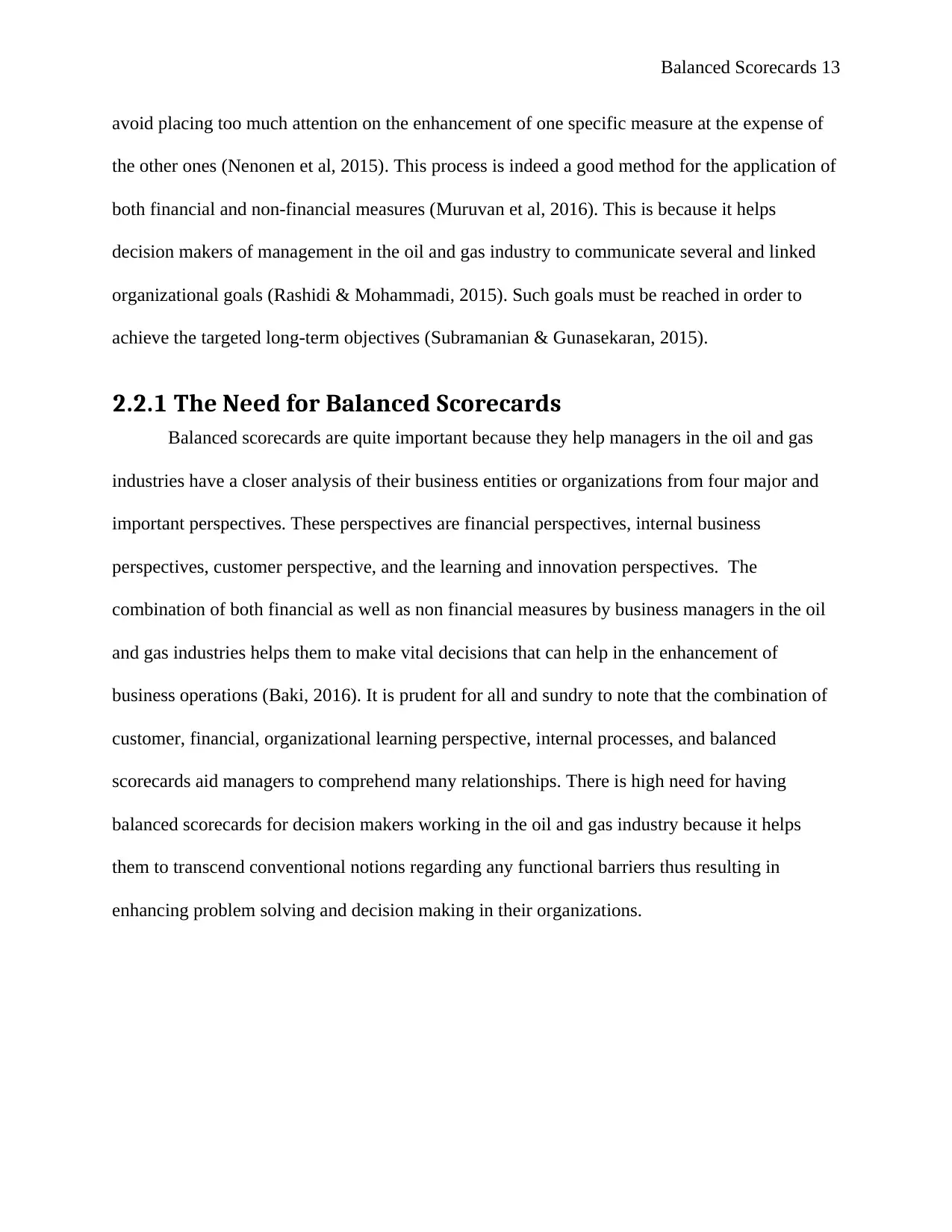
Balanced Scorecards 13
avoid placing too much attention on the enhancement of one specific measure at the expense of
the other ones (Nenonen et al, 2015). This process is indeed a good method for the application of
both financial and non-financial measures (Muruvan et al, 2016). This is because it helps
decision makers of management in the oil and gas industry to communicate several and linked
organizational goals (Rashidi & Mohammadi, 2015). Such goals must be reached in order to
achieve the targeted long-term objectives (Subramanian & Gunasekaran, 2015).
2.2.1 The Need for Balanced Scorecards
Balanced scorecards are quite important because they help managers in the oil and gas
industries have a closer analysis of their business entities or organizations from four major and
important perspectives. These perspectives are financial perspectives, internal business
perspectives, customer perspective, and the learning and innovation perspectives. The
combination of both financial as well as non financial measures by business managers in the oil
and gas industries helps them to make vital decisions that can help in the enhancement of
business operations (Baki, 2016). It is prudent for all and sundry to note that the combination of
customer, financial, organizational learning perspective, internal processes, and balanced
scorecards aid managers to comprehend many relationships. There is high need for having
balanced scorecards for decision makers working in the oil and gas industry because it helps
them to transcend conventional notions regarding any functional barriers thus resulting in
enhancing problem solving and decision making in their organizations.
avoid placing too much attention on the enhancement of one specific measure at the expense of
the other ones (Nenonen et al, 2015). This process is indeed a good method for the application of
both financial and non-financial measures (Muruvan et al, 2016). This is because it helps
decision makers of management in the oil and gas industry to communicate several and linked
organizational goals (Rashidi & Mohammadi, 2015). Such goals must be reached in order to
achieve the targeted long-term objectives (Subramanian & Gunasekaran, 2015).
2.2.1 The Need for Balanced Scorecards
Balanced scorecards are quite important because they help managers in the oil and gas
industries have a closer analysis of their business entities or organizations from four major and
important perspectives. These perspectives are financial perspectives, internal business
perspectives, customer perspective, and the learning and innovation perspectives. The
combination of both financial as well as non financial measures by business managers in the oil
and gas industries helps them to make vital decisions that can help in the enhancement of
business operations (Baki, 2016). It is prudent for all and sundry to note that the combination of
customer, financial, organizational learning perspective, internal processes, and balanced
scorecards aid managers to comprehend many relationships. There is high need for having
balanced scorecards for decision makers working in the oil and gas industry because it helps
them to transcend conventional notions regarding any functional barriers thus resulting in
enhancing problem solving and decision making in their organizations.
Paraphrase This Document
Need a fresh take? Get an instant paraphrase of this document with our AI Paraphraser
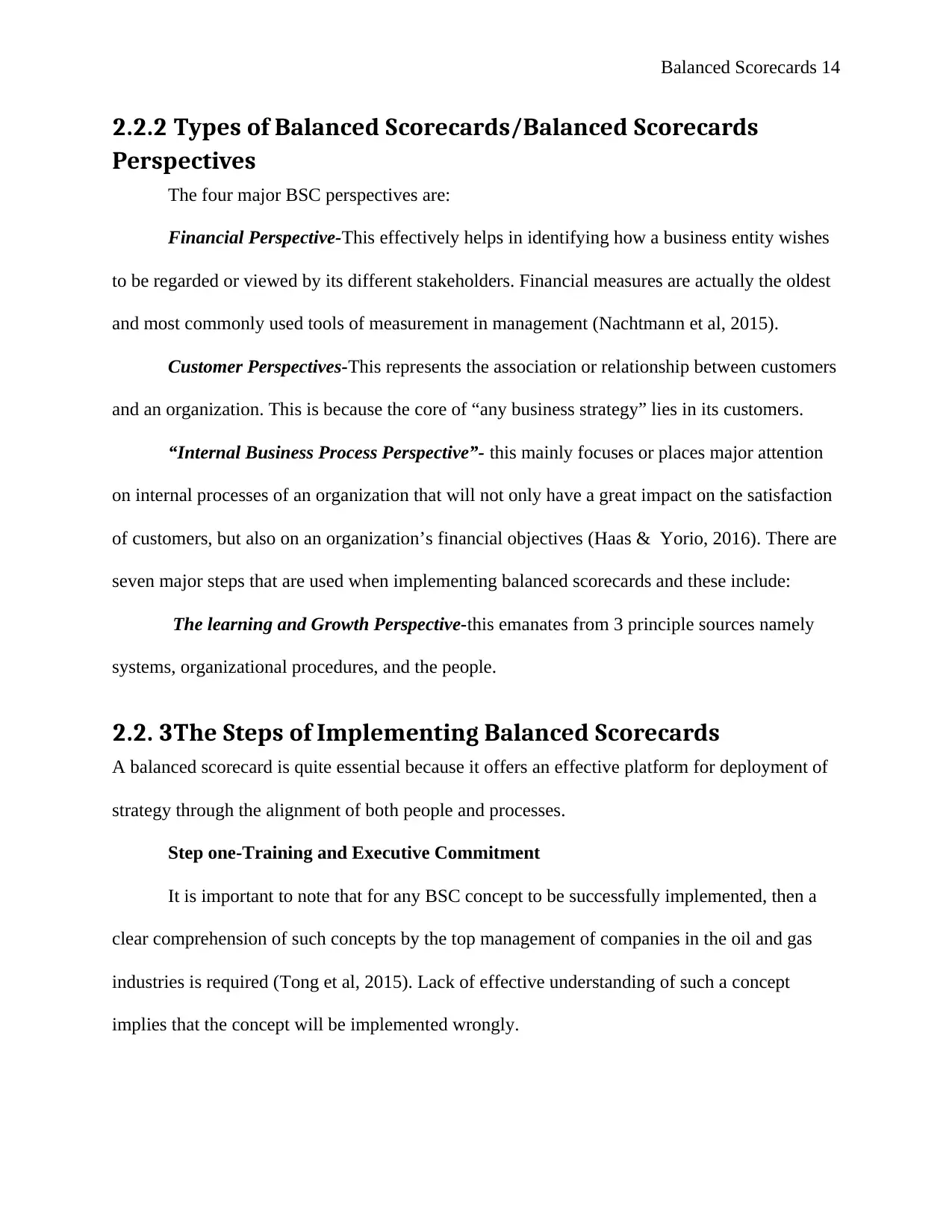
Balanced Scorecards 14
2.2.2 Types of Balanced Scorecards/Balanced Scorecards
Perspectives
The four major BSC perspectives are:
Financial Perspective-This effectively helps in identifying how a business entity wishes
to be regarded or viewed by its different stakeholders. Financial measures are actually the oldest
and most commonly used tools of measurement in management (Nachtmann et al, 2015).
Customer Perspectives-This represents the association or relationship between customers
and an organization. This is because the core of “any business strategy” lies in its customers.
“Internal Business Process Perspective”- this mainly focuses or places major attention
on internal processes of an organization that will not only have a great impact on the satisfaction
of customers, but also on an organization’s financial objectives (Haas & Yorio, 2016). There are
seven major steps that are used when implementing balanced scorecards and these include:
The learning and Growth Perspective-this emanates from 3 principle sources namely
systems, organizational procedures, and the people.
2.2. 3The Steps of Implementing Balanced Scorecards
A balanced scorecard is quite essential because it offers an effective platform for deployment of
strategy through the alignment of both people and processes.
Step one-Training and Executive Commitment
It is important to note that for any BSC concept to be successfully implemented, then a
clear comprehension of such concepts by the top management of companies in the oil and gas
industries is required (Tong et al, 2015). Lack of effective understanding of such a concept
implies that the concept will be implemented wrongly.
2.2.2 Types of Balanced Scorecards/Balanced Scorecards
Perspectives
The four major BSC perspectives are:
Financial Perspective-This effectively helps in identifying how a business entity wishes
to be regarded or viewed by its different stakeholders. Financial measures are actually the oldest
and most commonly used tools of measurement in management (Nachtmann et al, 2015).
Customer Perspectives-This represents the association or relationship between customers
and an organization. This is because the core of “any business strategy” lies in its customers.
“Internal Business Process Perspective”- this mainly focuses or places major attention
on internal processes of an organization that will not only have a great impact on the satisfaction
of customers, but also on an organization’s financial objectives (Haas & Yorio, 2016). There are
seven major steps that are used when implementing balanced scorecards and these include:
The learning and Growth Perspective-this emanates from 3 principle sources namely
systems, organizational procedures, and the people.
2.2. 3The Steps of Implementing Balanced Scorecards
A balanced scorecard is quite essential because it offers an effective platform for deployment of
strategy through the alignment of both people and processes.
Step one-Training and Executive Commitment
It is important to note that for any BSC concept to be successfully implemented, then a
clear comprehension of such concepts by the top management of companies in the oil and gas
industries is required (Tong et al, 2015). Lack of effective understanding of such a concept
implies that the concept will be implemented wrongly.
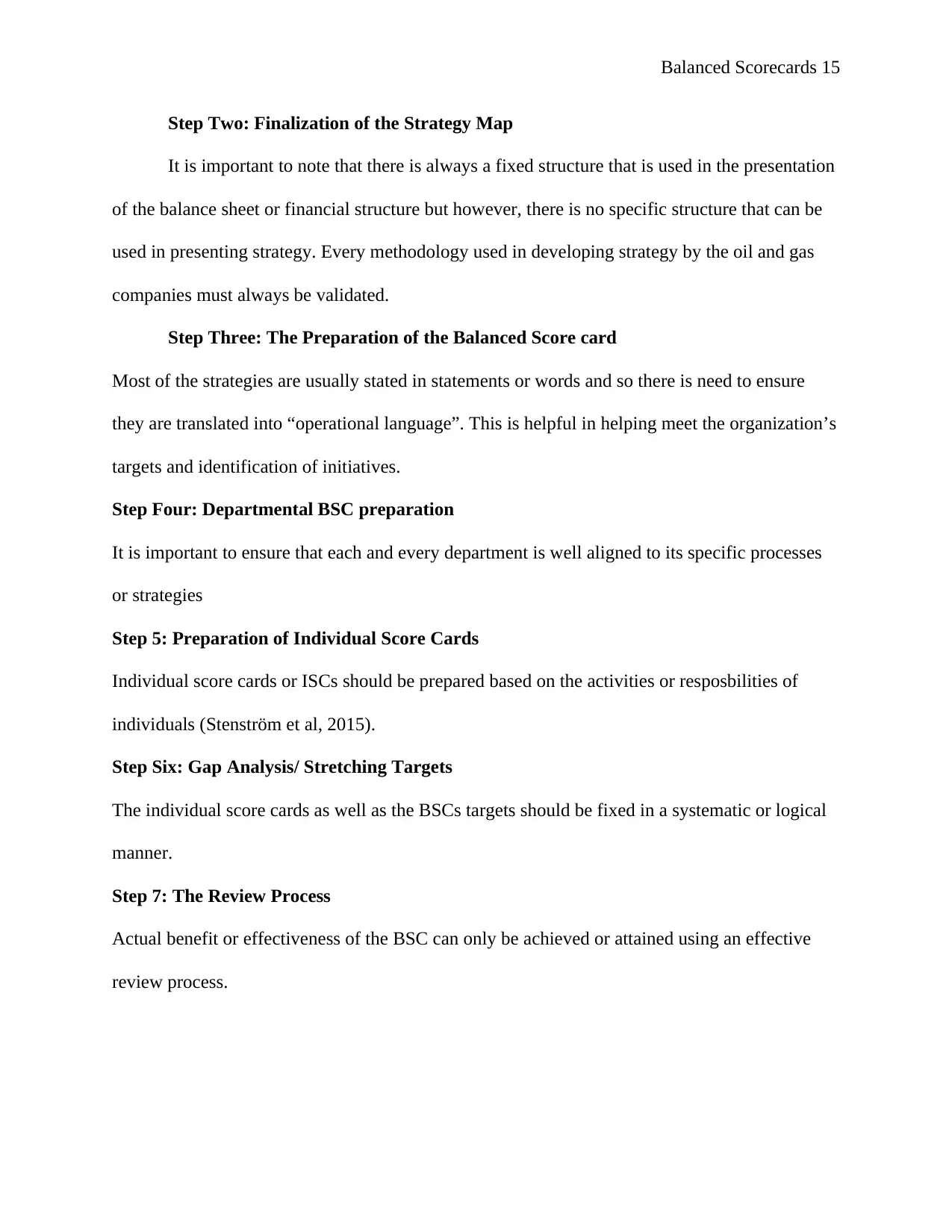
Balanced Scorecards 15
Step Two: Finalization of the Strategy Map
It is important to note that there is always a fixed structure that is used in the presentation
of the balance sheet or financial structure but however, there is no specific structure that can be
used in presenting strategy. Every methodology used in developing strategy by the oil and gas
companies must always be validated.
Step Three: The Preparation of the Balanced Score card
Most of the strategies are usually stated in statements or words and so there is need to ensure
they are translated into “operational language”. This is helpful in helping meet the organization’s
targets and identification of initiatives.
Step Four: Departmental BSC preparation
It is important to ensure that each and every department is well aligned to its specific processes
or strategies
Step 5: Preparation of Individual Score Cards
Individual score cards or ISCs should be prepared based on the activities or resposbilities of
individuals (Stenström et al, 2015).
Step Six: Gap Analysis/ Stretching Targets
The individual score cards as well as the BSCs targets should be fixed in a systematic or logical
manner.
Step 7: The Review Process
Actual benefit or effectiveness of the BSC can only be achieved or attained using an effective
review process.
Step Two: Finalization of the Strategy Map
It is important to note that there is always a fixed structure that is used in the presentation
of the balance sheet or financial structure but however, there is no specific structure that can be
used in presenting strategy. Every methodology used in developing strategy by the oil and gas
companies must always be validated.
Step Three: The Preparation of the Balanced Score card
Most of the strategies are usually stated in statements or words and so there is need to ensure
they are translated into “operational language”. This is helpful in helping meet the organization’s
targets and identification of initiatives.
Step Four: Departmental BSC preparation
It is important to ensure that each and every department is well aligned to its specific processes
or strategies
Step 5: Preparation of Individual Score Cards
Individual score cards or ISCs should be prepared based on the activities or resposbilities of
individuals (Stenström et al, 2015).
Step Six: Gap Analysis/ Stretching Targets
The individual score cards as well as the BSCs targets should be fixed in a systematic or logical
manner.
Step 7: The Review Process
Actual benefit or effectiveness of the BSC can only be achieved or attained using an effective
review process.
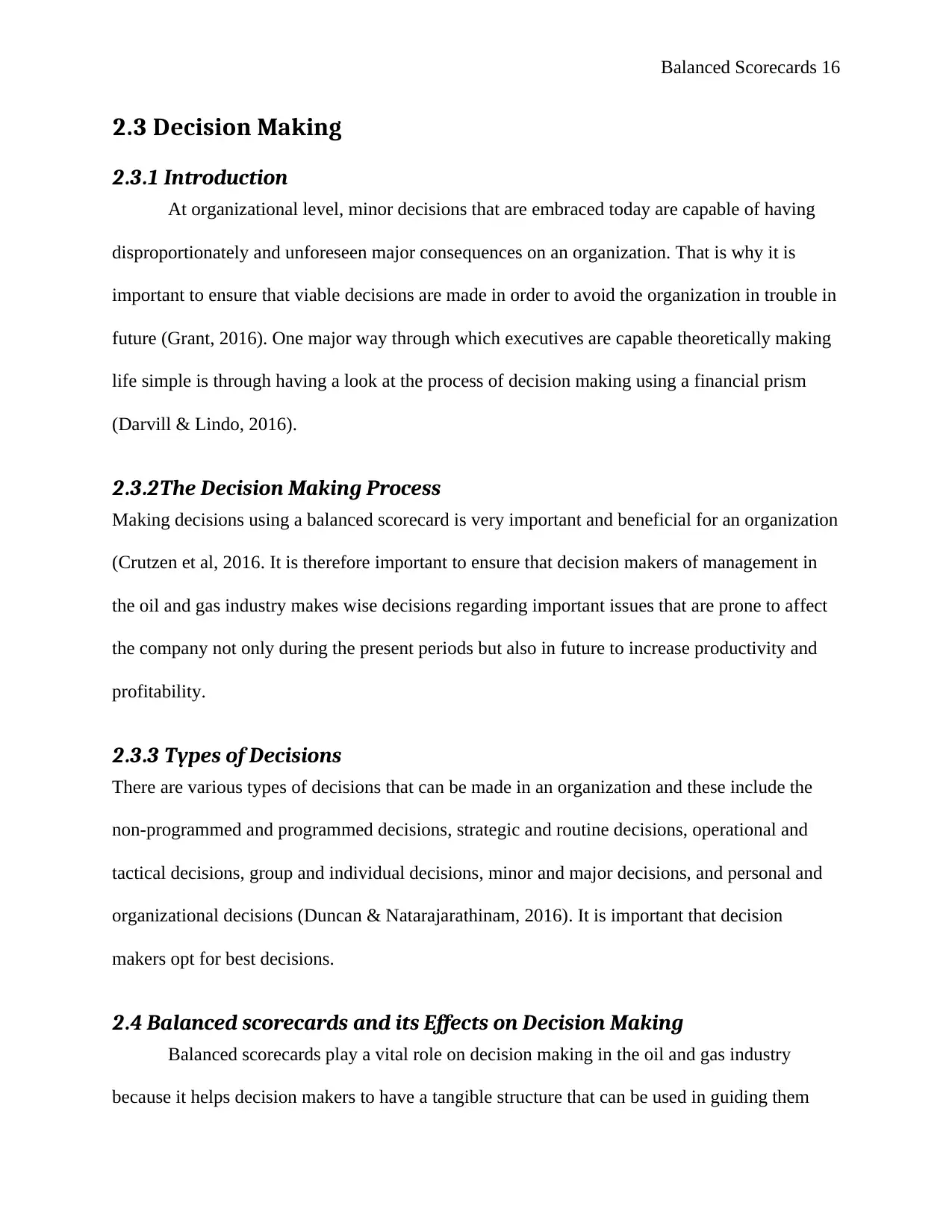
Balanced Scorecards 16
2.3 Decision Making
2.3.1 Introduction
At organizational level, minor decisions that are embraced today are capable of having
disproportionately and unforeseen major consequences on an organization. That is why it is
important to ensure that viable decisions are made in order to avoid the organization in trouble in
future (Grant, 2016). One major way through which executives are capable theoretically making
life simple is through having a look at the process of decision making using a financial prism
(Darvill & Lindo, 2016).
2.3.2The Decision Making Process
Making decisions using a balanced scorecard is very important and beneficial for an organization
(Crutzen et al, 2016. It is therefore important to ensure that decision makers of management in
the oil and gas industry makes wise decisions regarding important issues that are prone to affect
the company not only during the present periods but also in future to increase productivity and
profitability.
2.3.3 Types of Decisions
There are various types of decisions that can be made in an organization and these include the
non-programmed and programmed decisions, strategic and routine decisions, operational and
tactical decisions, group and individual decisions, minor and major decisions, and personal and
organizational decisions (Duncan & Natarajarathinam, 2016). It is important that decision
makers opt for best decisions.
2.4 Balanced scorecards and its Effects on Decision Making
Balanced scorecards play a vital role on decision making in the oil and gas industry
because it helps decision makers to have a tangible structure that can be used in guiding them
2.3 Decision Making
2.3.1 Introduction
At organizational level, minor decisions that are embraced today are capable of having
disproportionately and unforeseen major consequences on an organization. That is why it is
important to ensure that viable decisions are made in order to avoid the organization in trouble in
future (Grant, 2016). One major way through which executives are capable theoretically making
life simple is through having a look at the process of decision making using a financial prism
(Darvill & Lindo, 2016).
2.3.2The Decision Making Process
Making decisions using a balanced scorecard is very important and beneficial for an organization
(Crutzen et al, 2016. It is therefore important to ensure that decision makers of management in
the oil and gas industry makes wise decisions regarding important issues that are prone to affect
the company not only during the present periods but also in future to increase productivity and
profitability.
2.3.3 Types of Decisions
There are various types of decisions that can be made in an organization and these include the
non-programmed and programmed decisions, strategic and routine decisions, operational and
tactical decisions, group and individual decisions, minor and major decisions, and personal and
organizational decisions (Duncan & Natarajarathinam, 2016). It is important that decision
makers opt for best decisions.
2.4 Balanced scorecards and its Effects on Decision Making
Balanced scorecards play a vital role on decision making in the oil and gas industry
because it helps decision makers to have a tangible structure that can be used in guiding them
Secure Best Marks with AI Grader
Need help grading? Try our AI Grader for instant feedback on your assignments.
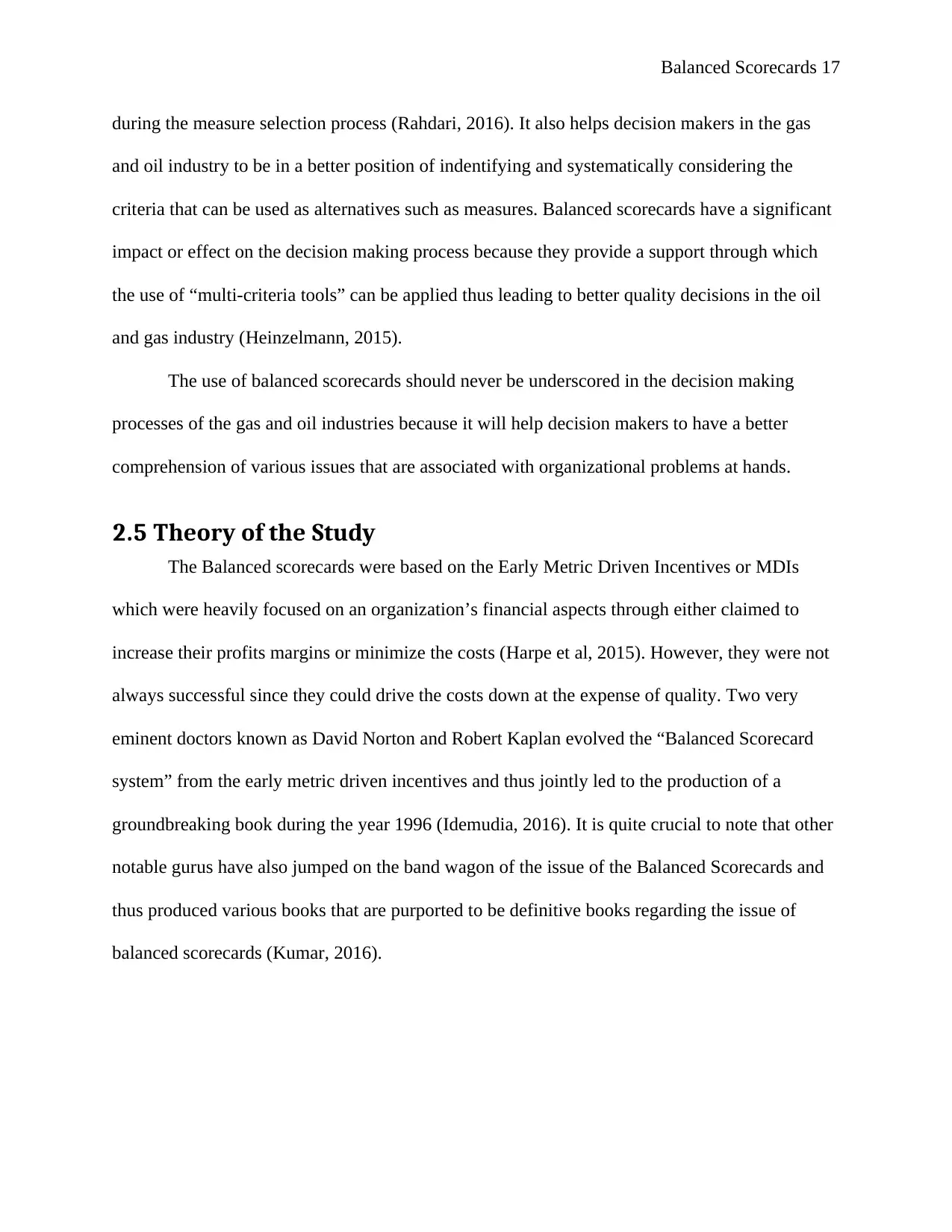
Balanced Scorecards 17
during the measure selection process (Rahdari, 2016). It also helps decision makers in the gas
and oil industry to be in a better position of indentifying and systematically considering the
criteria that can be used as alternatives such as measures. Balanced scorecards have a significant
impact or effect on the decision making process because they provide a support through which
the use of “multi-criteria tools” can be applied thus leading to better quality decisions in the oil
and gas industry (Heinzelmann, 2015).
The use of balanced scorecards should never be underscored in the decision making
processes of the gas and oil industries because it will help decision makers to have a better
comprehension of various issues that are associated with organizational problems at hands.
2.5 Theory of the Study
The Balanced scorecards were based on the Early Metric Driven Incentives or MDIs
which were heavily focused on an organization’s financial aspects through either claimed to
increase their profits margins or minimize the costs (Harpe et al, 2015). However, they were not
always successful since they could drive the costs down at the expense of quality. Two very
eminent doctors known as David Norton and Robert Kaplan evolved the “Balanced Scorecard
system” from the early metric driven incentives and thus jointly led to the production of a
groundbreaking book during the year 1996 (Idemudia, 2016). It is quite crucial to note that other
notable gurus have also jumped on the band wagon of the issue of the Balanced Scorecards and
thus produced various books that are purported to be definitive books regarding the issue of
balanced scorecards (Kumar, 2016).
during the measure selection process (Rahdari, 2016). It also helps decision makers in the gas
and oil industry to be in a better position of indentifying and systematically considering the
criteria that can be used as alternatives such as measures. Balanced scorecards have a significant
impact or effect on the decision making process because they provide a support through which
the use of “multi-criteria tools” can be applied thus leading to better quality decisions in the oil
and gas industry (Heinzelmann, 2015).
The use of balanced scorecards should never be underscored in the decision making
processes of the gas and oil industries because it will help decision makers to have a better
comprehension of various issues that are associated with organizational problems at hands.
2.5 Theory of the Study
The Balanced scorecards were based on the Early Metric Driven Incentives or MDIs
which were heavily focused on an organization’s financial aspects through either claimed to
increase their profits margins or minimize the costs (Harpe et al, 2015). However, they were not
always successful since they could drive the costs down at the expense of quality. Two very
eminent doctors known as David Norton and Robert Kaplan evolved the “Balanced Scorecard
system” from the early metric driven incentives and thus jointly led to the production of a
groundbreaking book during the year 1996 (Idemudia, 2016). It is quite crucial to note that other
notable gurus have also jumped on the band wagon of the issue of the Balanced Scorecards and
thus produced various books that are purported to be definitive books regarding the issue of
balanced scorecards (Kumar, 2016).
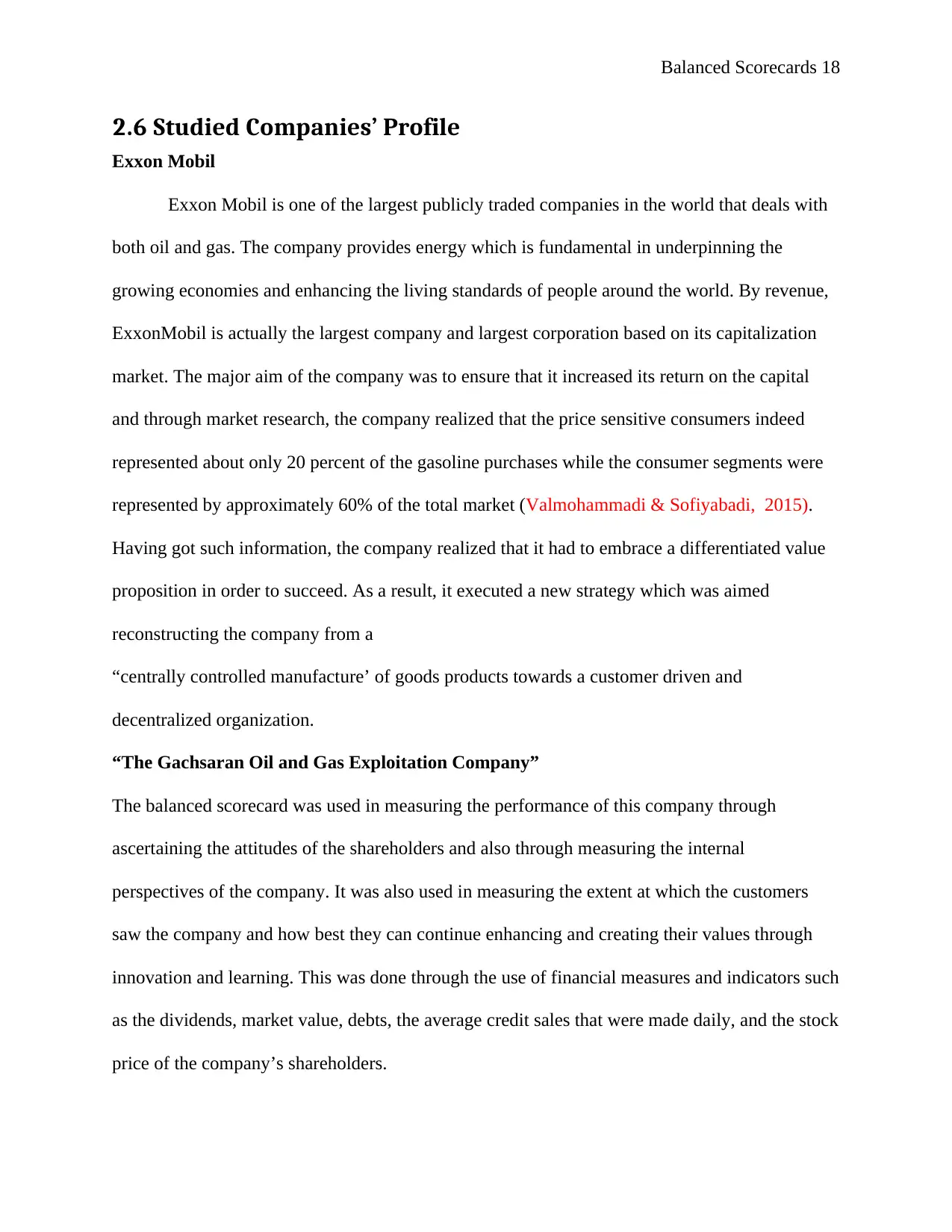
Balanced Scorecards 18
2.6 Studied Companies’ Profile
Exxon Mobil
Exxon Mobil is one of the largest publicly traded companies in the world that deals with
both oil and gas. The company provides energy which is fundamental in underpinning the
growing economies and enhancing the living standards of people around the world. By revenue,
ExxonMobil is actually the largest company and largest corporation based on its capitalization
market. The major aim of the company was to ensure that it increased its return on the capital
and through market research, the company realized that the price sensitive consumers indeed
represented about only 20 percent of the gasoline purchases while the consumer segments were
represented by approximately 60% of the total market (Valmohammadi & Sofiyabadi, 2015).
Having got such information, the company realized that it had to embrace a differentiated value
proposition in order to succeed. As a result, it executed a new strategy which was aimed
reconstructing the company from a
“centrally controlled manufacture’ of goods products towards a customer driven and
decentralized organization.
“The Gachsaran Oil and Gas Exploitation Company”
The balanced scorecard was used in measuring the performance of this company through
ascertaining the attitudes of the shareholders and also through measuring the internal
perspectives of the company. It was also used in measuring the extent at which the customers
saw the company and how best they can continue enhancing and creating their values through
innovation and learning. This was done through the use of financial measures and indicators such
as the dividends, market value, debts, the average credit sales that were made daily, and the stock
price of the company’s shareholders.
2.6 Studied Companies’ Profile
Exxon Mobil
Exxon Mobil is one of the largest publicly traded companies in the world that deals with
both oil and gas. The company provides energy which is fundamental in underpinning the
growing economies and enhancing the living standards of people around the world. By revenue,
ExxonMobil is actually the largest company and largest corporation based on its capitalization
market. The major aim of the company was to ensure that it increased its return on the capital
and through market research, the company realized that the price sensitive consumers indeed
represented about only 20 percent of the gasoline purchases while the consumer segments were
represented by approximately 60% of the total market (Valmohammadi & Sofiyabadi, 2015).
Having got such information, the company realized that it had to embrace a differentiated value
proposition in order to succeed. As a result, it executed a new strategy which was aimed
reconstructing the company from a
“centrally controlled manufacture’ of goods products towards a customer driven and
decentralized organization.
“The Gachsaran Oil and Gas Exploitation Company”
The balanced scorecard was used in measuring the performance of this company through
ascertaining the attitudes of the shareholders and also through measuring the internal
perspectives of the company. It was also used in measuring the extent at which the customers
saw the company and how best they can continue enhancing and creating their values through
innovation and learning. This was done through the use of financial measures and indicators such
as the dividends, market value, debts, the average credit sales that were made daily, and the stock
price of the company’s shareholders.
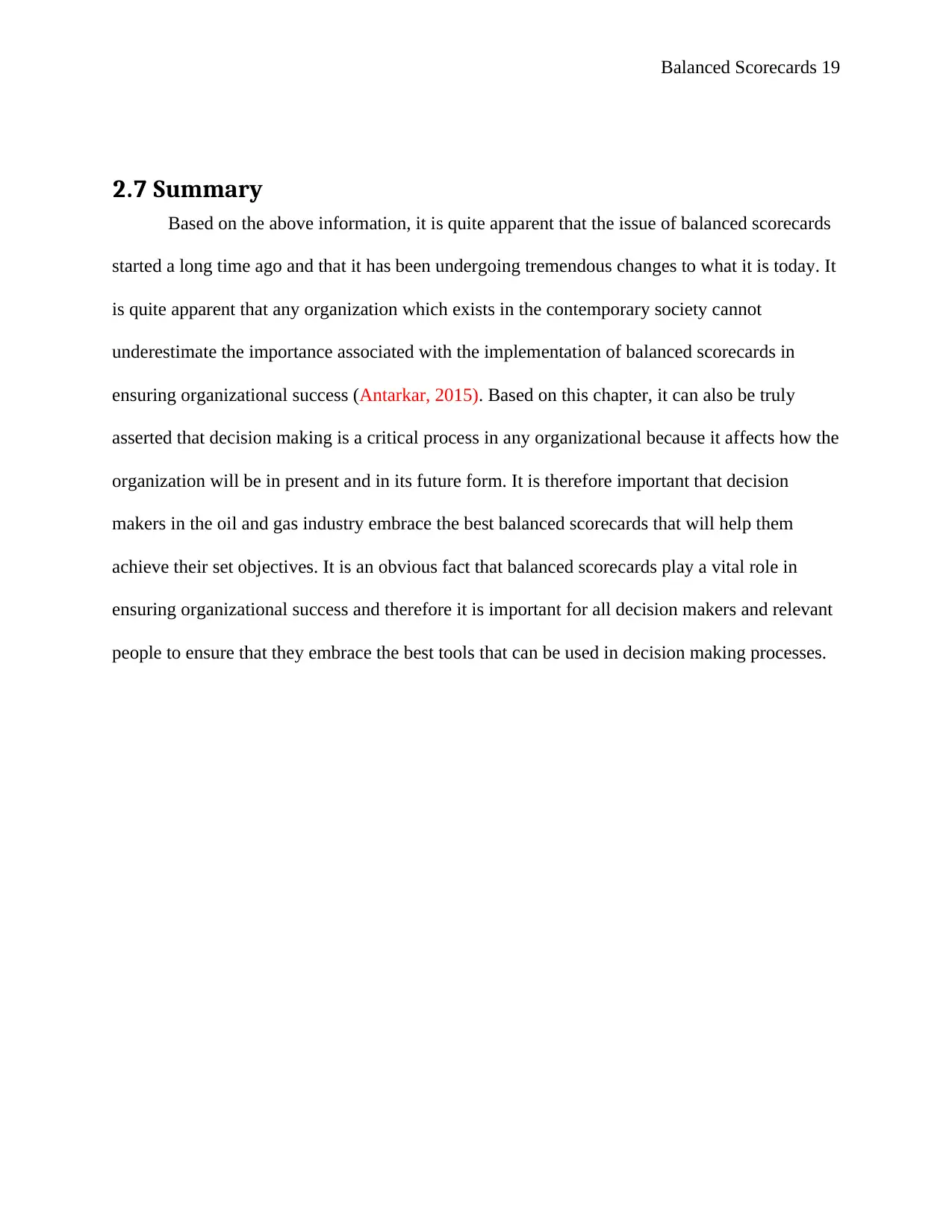
Balanced Scorecards 19
2.7 Summary
Based on the above information, it is quite apparent that the issue of balanced scorecards
started a long time ago and that it has been undergoing tremendous changes to what it is today. It
is quite apparent that any organization which exists in the contemporary society cannot
underestimate the importance associated with the implementation of balanced scorecards in
ensuring organizational success (Antarkar, 2015). Based on this chapter, it can also be truly
asserted that decision making is a critical process in any organizational because it affects how the
organization will be in present and in its future form. It is therefore important that decision
makers in the oil and gas industry embrace the best balanced scorecards that will help them
achieve their set objectives. It is an obvious fact that balanced scorecards play a vital role in
ensuring organizational success and therefore it is important for all decision makers and relevant
people to ensure that they embrace the best tools that can be used in decision making processes.
2.7 Summary
Based on the above information, it is quite apparent that the issue of balanced scorecards
started a long time ago and that it has been undergoing tremendous changes to what it is today. It
is quite apparent that any organization which exists in the contemporary society cannot
underestimate the importance associated with the implementation of balanced scorecards in
ensuring organizational success (Antarkar, 2015). Based on this chapter, it can also be truly
asserted that decision making is a critical process in any organizational because it affects how the
organization will be in present and in its future form. It is therefore important that decision
makers in the oil and gas industry embrace the best balanced scorecards that will help them
achieve their set objectives. It is an obvious fact that balanced scorecards play a vital role in
ensuring organizational success and therefore it is important for all decision makers and relevant
people to ensure that they embrace the best tools that can be used in decision making processes.
Paraphrase This Document
Need a fresh take? Get an instant paraphrase of this document with our AI Paraphraser
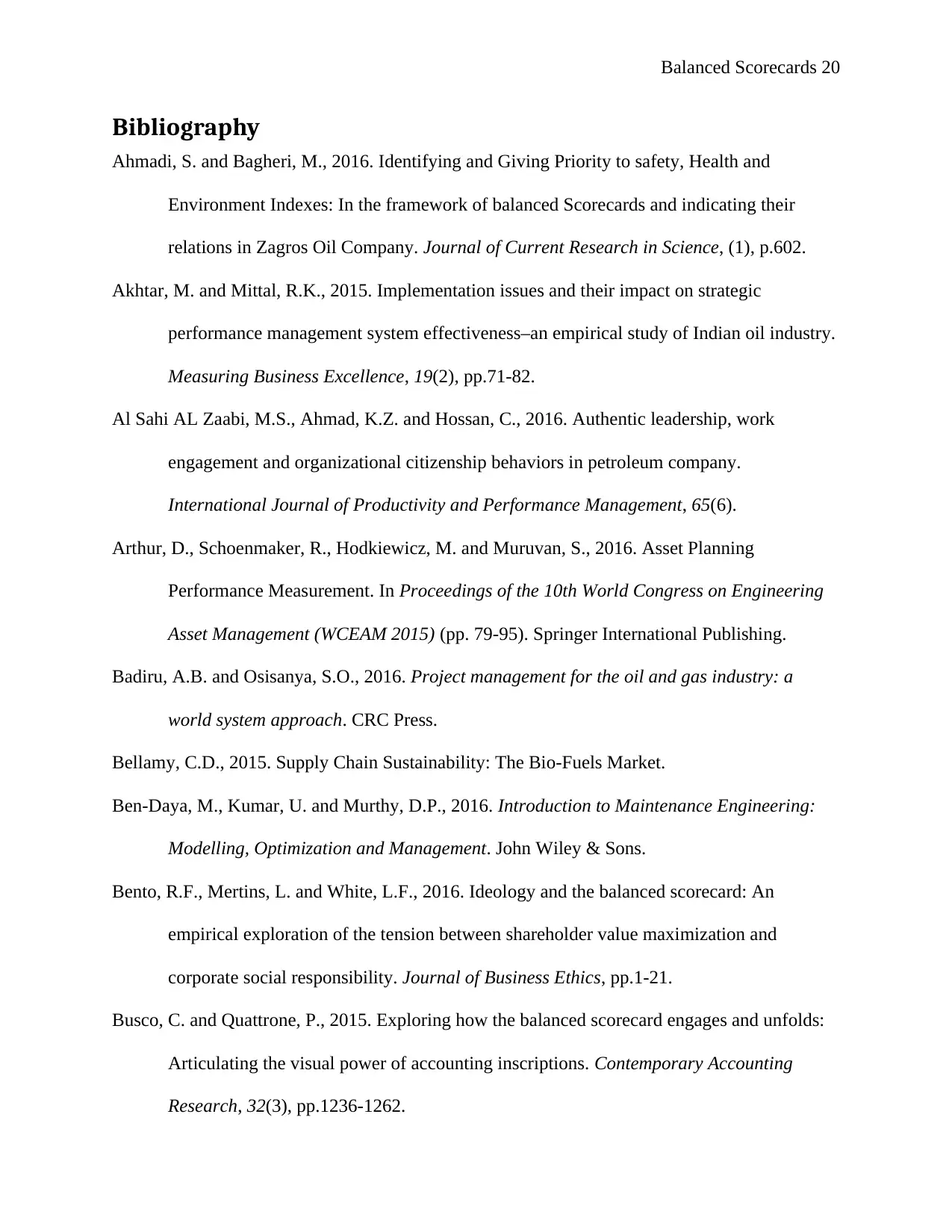
Balanced Scorecards 20
Bibliography
Ahmadi, S. and Bagheri, M., 2016. Identifying and Giving Priority to safety, Health and
Environment Indexes: In the framework of balanced Scorecards and indicating their
relations in Zagros Oil Company. Journal of Current Research in Science, (1), p.602.
Akhtar, M. and Mittal, R.K., 2015. Implementation issues and their impact on strategic
performance management system effectiveness–an empirical study of Indian oil industry.
Measuring Business Excellence, 19(2), pp.71-82.
Al Sahi AL Zaabi, M.S., Ahmad, K.Z. and Hossan, C., 2016. Authentic leadership, work
engagement and organizational citizenship behaviors in petroleum company.
International Journal of Productivity and Performance Management, 65(6).
Arthur, D., Schoenmaker, R., Hodkiewicz, M. and Muruvan, S., 2016. Asset Planning
Performance Measurement. In Proceedings of the 10th World Congress on Engineering
Asset Management (WCEAM 2015) (pp. 79-95). Springer International Publishing.
Badiru, A.B. and Osisanya, S.O., 2016. Project management for the oil and gas industry: a
world system approach. CRC Press.
Bellamy, C.D., 2015. Supply Chain Sustainability: The Bio-Fuels Market.
Ben-Daya, M., Kumar, U. and Murthy, D.P., 2016. Introduction to Maintenance Engineering:
Modelling, Optimization and Management. John Wiley & Sons.
Bento, R.F., Mertins, L. and White, L.F., 2016. Ideology and the balanced scorecard: An
empirical exploration of the tension between shareholder value maximization and
corporate social responsibility. Journal of Business Ethics, pp.1-21.
Busco, C. and Quattrone, P., 2015. Exploring how the balanced scorecard engages and unfolds:
Articulating the visual power of accounting inscriptions. Contemporary Accounting
Research, 32(3), pp.1236-1262.
Bibliography
Ahmadi, S. and Bagheri, M., 2016. Identifying and Giving Priority to safety, Health and
Environment Indexes: In the framework of balanced Scorecards and indicating their
relations in Zagros Oil Company. Journal of Current Research in Science, (1), p.602.
Akhtar, M. and Mittal, R.K., 2015. Implementation issues and their impact on strategic
performance management system effectiveness–an empirical study of Indian oil industry.
Measuring Business Excellence, 19(2), pp.71-82.
Al Sahi AL Zaabi, M.S., Ahmad, K.Z. and Hossan, C., 2016. Authentic leadership, work
engagement and organizational citizenship behaviors in petroleum company.
International Journal of Productivity and Performance Management, 65(6).
Arthur, D., Schoenmaker, R., Hodkiewicz, M. and Muruvan, S., 2016. Asset Planning
Performance Measurement. In Proceedings of the 10th World Congress on Engineering
Asset Management (WCEAM 2015) (pp. 79-95). Springer International Publishing.
Badiru, A.B. and Osisanya, S.O., 2016. Project management for the oil and gas industry: a
world system approach. CRC Press.
Bellamy, C.D., 2015. Supply Chain Sustainability: The Bio-Fuels Market.
Ben-Daya, M., Kumar, U. and Murthy, D.P., 2016. Introduction to Maintenance Engineering:
Modelling, Optimization and Management. John Wiley & Sons.
Bento, R.F., Mertins, L. and White, L.F., 2016. Ideology and the balanced scorecard: An
empirical exploration of the tension between shareholder value maximization and
corporate social responsibility. Journal of Business Ethics, pp.1-21.
Busco, C. and Quattrone, P., 2015. Exploring how the balanced scorecard engages and unfolds:
Articulating the visual power of accounting inscriptions. Contemporary Accounting
Research, 32(3), pp.1236-1262.
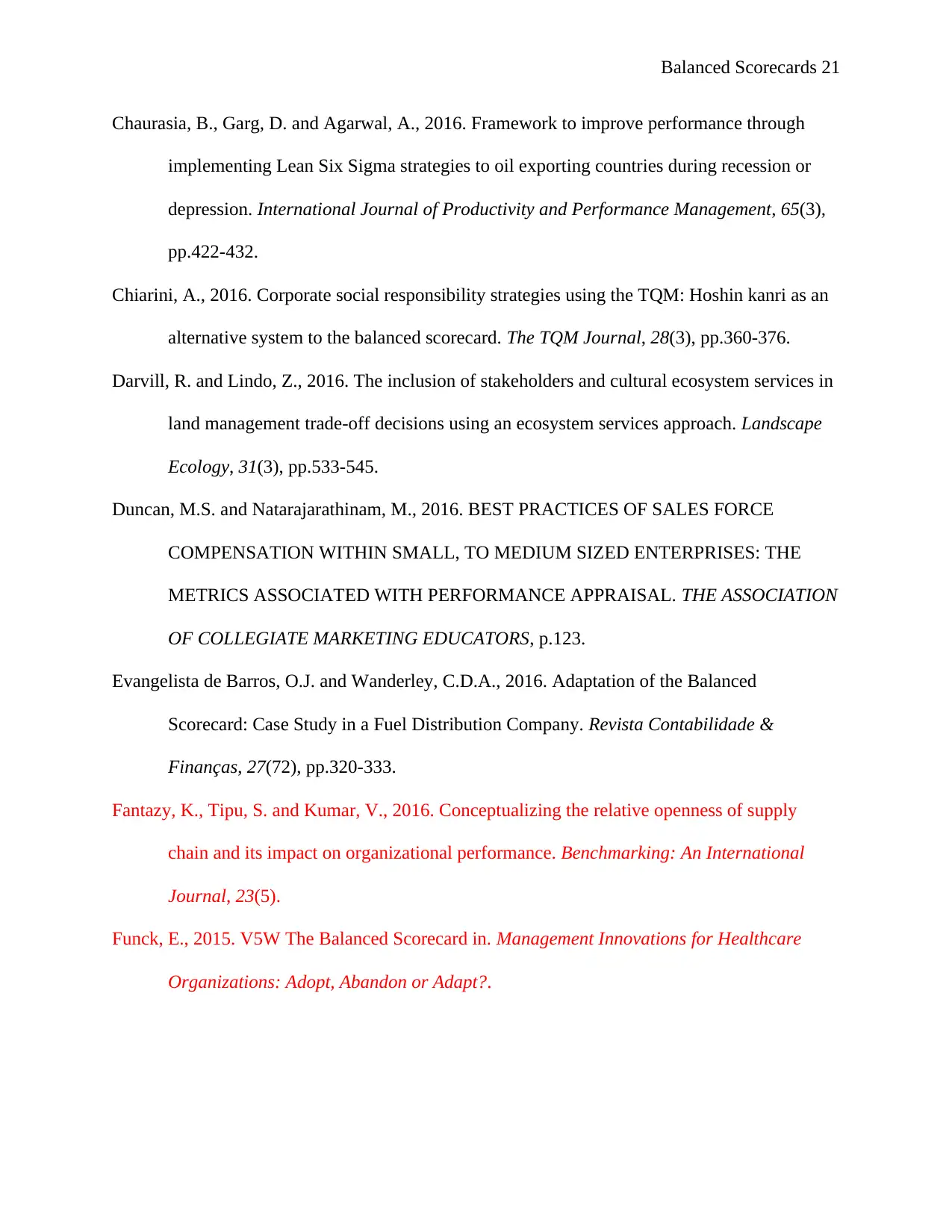
Balanced Scorecards 21
Chaurasia, B., Garg, D. and Agarwal, A., 2016. Framework to improve performance through
implementing Lean Six Sigma strategies to oil exporting countries during recession or
depression. International Journal of Productivity and Performance Management, 65(3),
pp.422-432.
Chiarini, A., 2016. Corporate social responsibility strategies using the TQM: Hoshin kanri as an
alternative system to the balanced scorecard. The TQM Journal, 28(3), pp.360-376.
Darvill, R. and Lindo, Z., 2016. The inclusion of stakeholders and cultural ecosystem services in
land management trade-off decisions using an ecosystem services approach. Landscape
Ecology, 31(3), pp.533-545.
Duncan, M.S. and Natarajarathinam, M., 2016. BEST PRACTICES OF SALES FORCE
COMPENSATION WITHIN SMALL, TO MEDIUM SIZED ENTERPRISES: THE
METRICS ASSOCIATED WITH PERFORMANCE APPRAISAL. THE ASSOCIATION
OF COLLEGIATE MARKETING EDUCATORS, p.123.
Evangelista de Barros, O.J. and Wanderley, C.D.A., 2016. Adaptation of the Balanced
Scorecard: Case Study in a Fuel Distribution Company. Revista Contabilidade &
Finanças, 27(72), pp.320-333.
Fantazy, K., Tipu, S. and Kumar, V., 2016. Conceptualizing the relative openness of supply
chain and its impact on organizational performance. Benchmarking: An International
Journal, 23(5).
Funck, E., 2015. V5W The Balanced Scorecard in. Management Innovations for Healthcare
Organizations: Adopt, Abandon or Adapt?.
Chaurasia, B., Garg, D. and Agarwal, A., 2016. Framework to improve performance through
implementing Lean Six Sigma strategies to oil exporting countries during recession or
depression. International Journal of Productivity and Performance Management, 65(3),
pp.422-432.
Chiarini, A., 2016. Corporate social responsibility strategies using the TQM: Hoshin kanri as an
alternative system to the balanced scorecard. The TQM Journal, 28(3), pp.360-376.
Darvill, R. and Lindo, Z., 2016. The inclusion of stakeholders and cultural ecosystem services in
land management trade-off decisions using an ecosystem services approach. Landscape
Ecology, 31(3), pp.533-545.
Duncan, M.S. and Natarajarathinam, M., 2016. BEST PRACTICES OF SALES FORCE
COMPENSATION WITHIN SMALL, TO MEDIUM SIZED ENTERPRISES: THE
METRICS ASSOCIATED WITH PERFORMANCE APPRAISAL. THE ASSOCIATION
OF COLLEGIATE MARKETING EDUCATORS, p.123.
Evangelista de Barros, O.J. and Wanderley, C.D.A., 2016. Adaptation of the Balanced
Scorecard: Case Study in a Fuel Distribution Company. Revista Contabilidade &
Finanças, 27(72), pp.320-333.
Fantazy, K., Tipu, S. and Kumar, V., 2016. Conceptualizing the relative openness of supply
chain and its impact on organizational performance. Benchmarking: An International
Journal, 23(5).
Funck, E., 2015. V5W The Balanced Scorecard in. Management Innovations for Healthcare
Organizations: Adopt, Abandon or Adapt?.
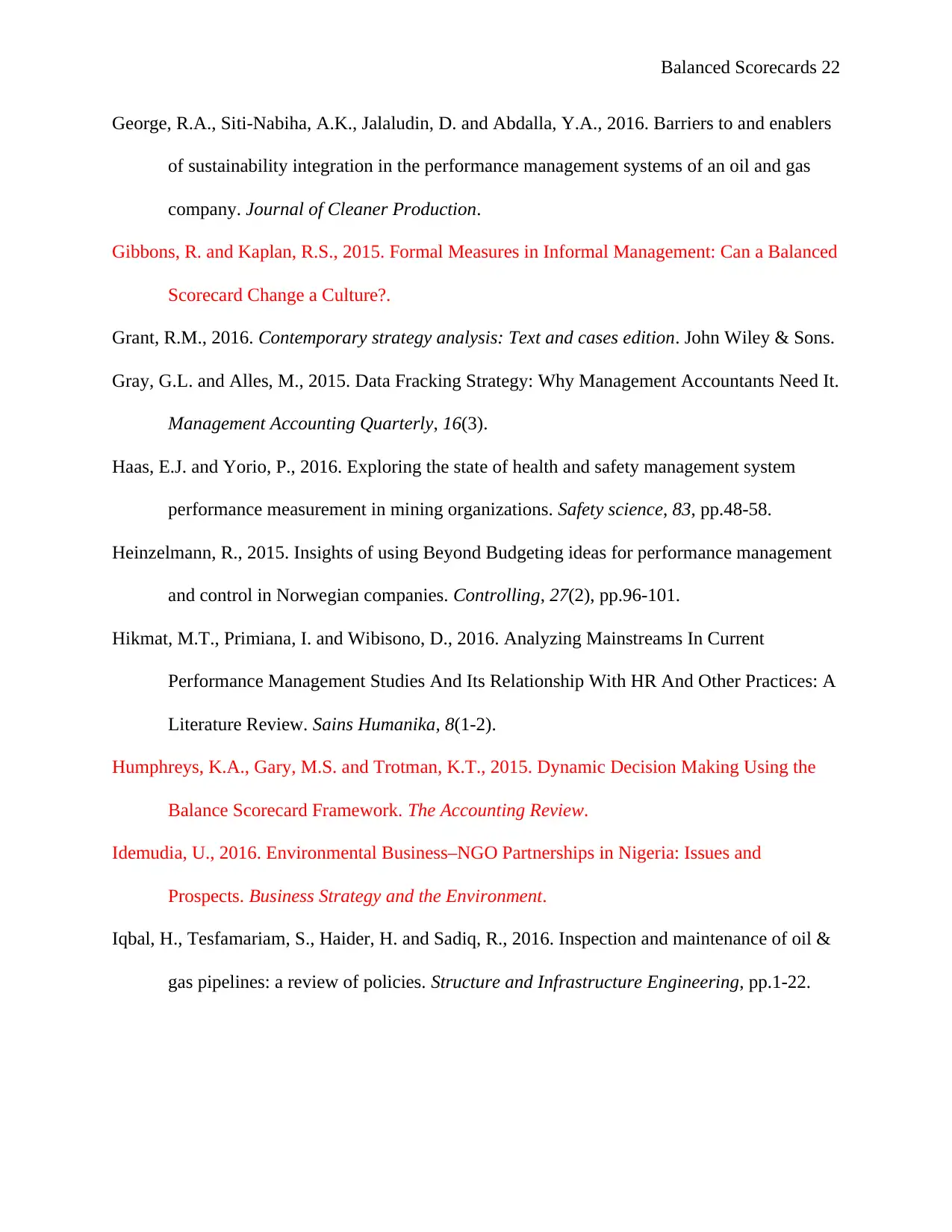
Balanced Scorecards 22
George, R.A., Siti-Nabiha, A.K., Jalaludin, D. and Abdalla, Y.A., 2016. Barriers to and enablers
of sustainability integration in the performance management systems of an oil and gas
company. Journal of Cleaner Production.
Gibbons, R. and Kaplan, R.S., 2015. Formal Measures in Informal Management: Can a Balanced
Scorecard Change a Culture?.
Grant, R.M., 2016. Contemporary strategy analysis: Text and cases edition. John Wiley & Sons.
Gray, G.L. and Alles, M., 2015. Data Fracking Strategy: Why Management Accountants Need It.
Management Accounting Quarterly, 16(3).
Haas, E.J. and Yorio, P., 2016. Exploring the state of health and safety management system
performance measurement in mining organizations. Safety science, 83, pp.48-58.
Heinzelmann, R., 2015. Insights of using Beyond Budgeting ideas for performance management
and control in Norwegian companies. Controlling, 27(2), pp.96-101.
Hikmat, M.T., Primiana, I. and Wibisono, D., 2016. Analyzing Mainstreams In Current
Performance Management Studies And Its Relationship With HR And Other Practices: A
Literature Review. Sains Humanika, 8(1-2).
Humphreys, K.A., Gary, M.S. and Trotman, K.T., 2015. Dynamic Decision Making Using the
Balance Scorecard Framework. The Accounting Review.
Idemudia, U., 2016. Environmental Business–NGO Partnerships in Nigeria: Issues and
Prospects. Business Strategy and the Environment.
Iqbal, H., Tesfamariam, S., Haider, H. and Sadiq, R., 2016. Inspection and maintenance of oil &
gas pipelines: a review of policies. Structure and Infrastructure Engineering, pp.1-22.
George, R.A., Siti-Nabiha, A.K., Jalaludin, D. and Abdalla, Y.A., 2016. Barriers to and enablers
of sustainability integration in the performance management systems of an oil and gas
company. Journal of Cleaner Production.
Gibbons, R. and Kaplan, R.S., 2015. Formal Measures in Informal Management: Can a Balanced
Scorecard Change a Culture?.
Grant, R.M., 2016. Contemporary strategy analysis: Text and cases edition. John Wiley & Sons.
Gray, G.L. and Alles, M., 2015. Data Fracking Strategy: Why Management Accountants Need It.
Management Accounting Quarterly, 16(3).
Haas, E.J. and Yorio, P., 2016. Exploring the state of health and safety management system
performance measurement in mining organizations. Safety science, 83, pp.48-58.
Heinzelmann, R., 2015. Insights of using Beyond Budgeting ideas for performance management
and control in Norwegian companies. Controlling, 27(2), pp.96-101.
Hikmat, M.T., Primiana, I. and Wibisono, D., 2016. Analyzing Mainstreams In Current
Performance Management Studies And Its Relationship With HR And Other Practices: A
Literature Review. Sains Humanika, 8(1-2).
Humphreys, K.A., Gary, M.S. and Trotman, K.T., 2015. Dynamic Decision Making Using the
Balance Scorecard Framework. The Accounting Review.
Idemudia, U., 2016. Environmental Business–NGO Partnerships in Nigeria: Issues and
Prospects. Business Strategy and the Environment.
Iqbal, H., Tesfamariam, S., Haider, H. and Sadiq, R., 2016. Inspection and maintenance of oil &
gas pipelines: a review of policies. Structure and Infrastructure Engineering, pp.1-22.
Secure Best Marks with AI Grader
Need help grading? Try our AI Grader for instant feedback on your assignments.
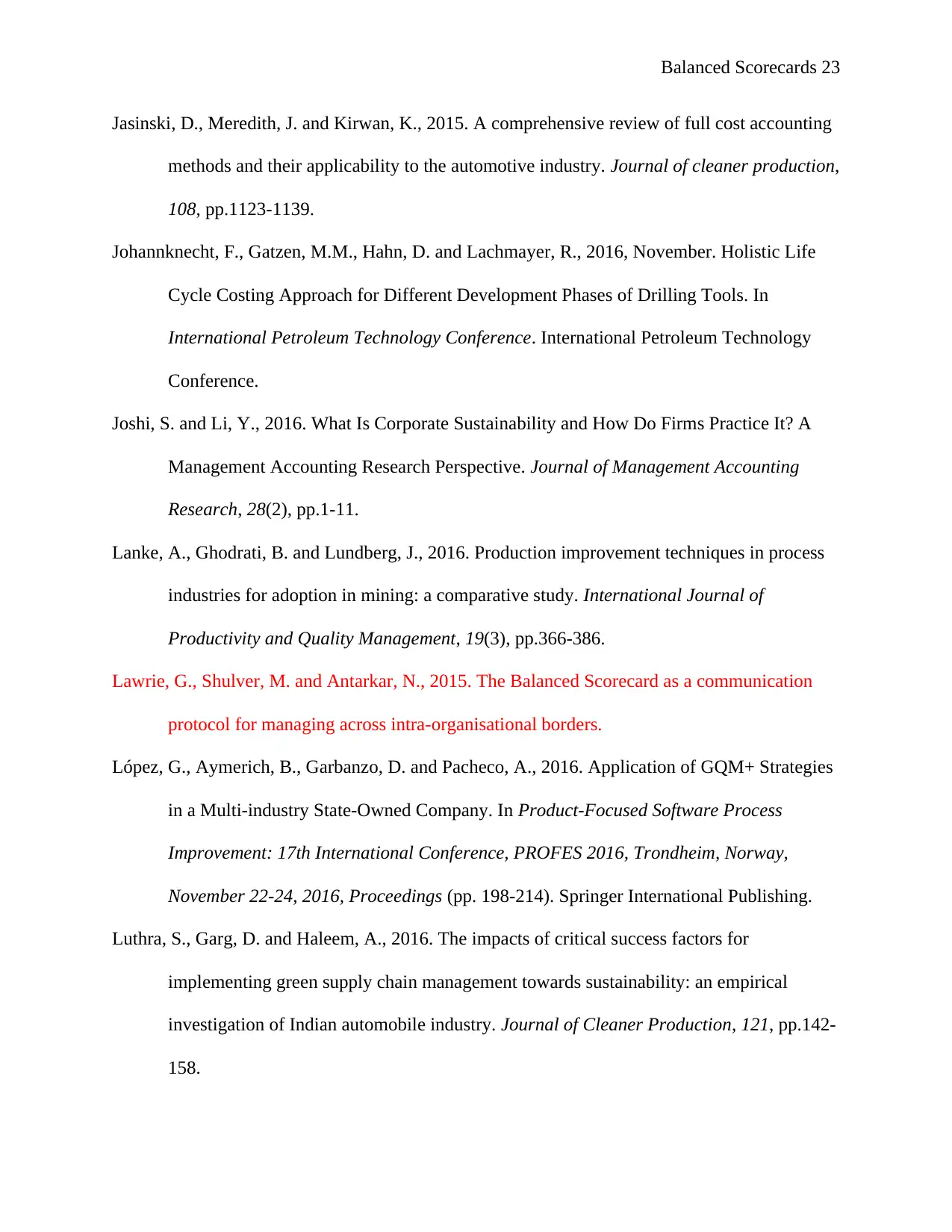
Balanced Scorecards 23
Jasinski, D., Meredith, J. and Kirwan, K., 2015. A comprehensive review of full cost accounting
methods and their applicability to the automotive industry. Journal of cleaner production,
108, pp.1123-1139.
Johannknecht, F., Gatzen, M.M., Hahn, D. and Lachmayer, R., 2016, November. Holistic Life
Cycle Costing Approach for Different Development Phases of Drilling Tools. In
International Petroleum Technology Conference. International Petroleum Technology
Conference.
Joshi, S. and Li, Y., 2016. What Is Corporate Sustainability and How Do Firms Practice It? A
Management Accounting Research Perspective. Journal of Management Accounting
Research, 28(2), pp.1-11.
Lanke, A., Ghodrati, B. and Lundberg, J., 2016. Production improvement techniques in process
industries for adoption in mining: a comparative study. International Journal of
Productivity and Quality Management, 19(3), pp.366-386.
Lawrie, G., Shulver, M. and Antarkar, N., 2015. The Balanced Scorecard as a communication
protocol for managing across intra-organisational borders.
López, G., Aymerich, B., Garbanzo, D. and Pacheco, A., 2016. Application of GQM+ Strategies
in a Multi-industry State-Owned Company. In Product-Focused Software Process
Improvement: 17th International Conference, PROFES 2016, Trondheim, Norway,
November 22-24, 2016, Proceedings (pp. 198-214). Springer International Publishing.
Luthra, S., Garg, D. and Haleem, A., 2016. The impacts of critical success factors for
implementing green supply chain management towards sustainability: an empirical
investigation of Indian automobile industry. Journal of Cleaner Production, 121, pp.142-
158.
Jasinski, D., Meredith, J. and Kirwan, K., 2015. A comprehensive review of full cost accounting
methods and their applicability to the automotive industry. Journal of cleaner production,
108, pp.1123-1139.
Johannknecht, F., Gatzen, M.M., Hahn, D. and Lachmayer, R., 2016, November. Holistic Life
Cycle Costing Approach for Different Development Phases of Drilling Tools. In
International Petroleum Technology Conference. International Petroleum Technology
Conference.
Joshi, S. and Li, Y., 2016. What Is Corporate Sustainability and How Do Firms Practice It? A
Management Accounting Research Perspective. Journal of Management Accounting
Research, 28(2), pp.1-11.
Lanke, A., Ghodrati, B. and Lundberg, J., 2016. Production improvement techniques in process
industries for adoption in mining: a comparative study. International Journal of
Productivity and Quality Management, 19(3), pp.366-386.
Lawrie, G., Shulver, M. and Antarkar, N., 2015. The Balanced Scorecard as a communication
protocol for managing across intra-organisational borders.
López, G., Aymerich, B., Garbanzo, D. and Pacheco, A., 2016. Application of GQM+ Strategies
in a Multi-industry State-Owned Company. In Product-Focused Software Process
Improvement: 17th International Conference, PROFES 2016, Trondheim, Norway,
November 22-24, 2016, Proceedings (pp. 198-214). Springer International Publishing.
Luthra, S., Garg, D. and Haleem, A., 2016. The impacts of critical success factors for
implementing green supply chain management towards sustainability: an empirical
investigation of Indian automobile industry. Journal of Cleaner Production, 121, pp.142-
158.
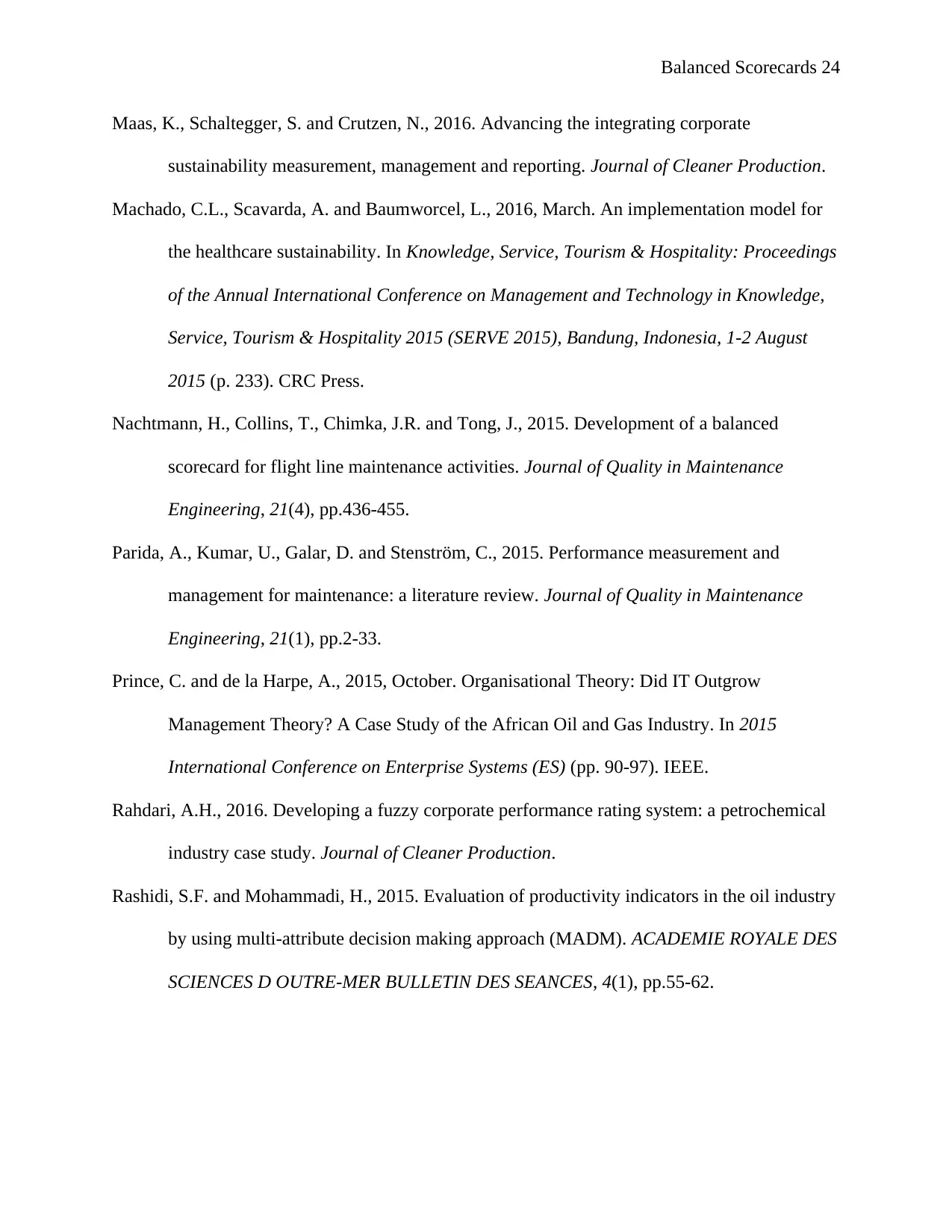
Balanced Scorecards 24
Maas, K., Schaltegger, S. and Crutzen, N., 2016. Advancing the integrating corporate
sustainability measurement, management and reporting. Journal of Cleaner Production.
Machado, C.L., Scavarda, A. and Baumworcel, L., 2016, March. An implementation model for
the healthcare sustainability. In Knowledge, Service, Tourism & Hospitality: Proceedings
of the Annual International Conference on Management and Technology in Knowledge,
Service, Tourism & Hospitality 2015 (SERVE 2015), Bandung, Indonesia, 1-2 August
2015 (p. 233). CRC Press.
Nachtmann, H., Collins, T., Chimka, J.R. and Tong, J., 2015. Development of a balanced
scorecard for flight line maintenance activities. Journal of Quality in Maintenance
Engineering, 21(4), pp.436-455.
Parida, A., Kumar, U., Galar, D. and Stenström, C., 2015. Performance measurement and
management for maintenance: a literature review. Journal of Quality in Maintenance
Engineering, 21(1), pp.2-33.
Prince, C. and de la Harpe, A., 2015, October. Organisational Theory: Did IT Outgrow
Management Theory? A Case Study of the African Oil and Gas Industry. In 2015
International Conference on Enterprise Systems (ES) (pp. 90-97). IEEE.
Rahdari, A.H., 2016. Developing a fuzzy corporate performance rating system: a petrochemical
industry case study. Journal of Cleaner Production.
Rashidi, S.F. and Mohammadi, H., 2015. Evaluation of productivity indicators in the oil industry
by using multi-attribute decision making approach (MADM). ACADEMIE ROYALE DES
SCIENCES D OUTRE-MER BULLETIN DES SEANCES, 4(1), pp.55-62.
Maas, K., Schaltegger, S. and Crutzen, N., 2016. Advancing the integrating corporate
sustainability measurement, management and reporting. Journal of Cleaner Production.
Machado, C.L., Scavarda, A. and Baumworcel, L., 2016, March. An implementation model for
the healthcare sustainability. In Knowledge, Service, Tourism & Hospitality: Proceedings
of the Annual International Conference on Management and Technology in Knowledge,
Service, Tourism & Hospitality 2015 (SERVE 2015), Bandung, Indonesia, 1-2 August
2015 (p. 233). CRC Press.
Nachtmann, H., Collins, T., Chimka, J.R. and Tong, J., 2015. Development of a balanced
scorecard for flight line maintenance activities. Journal of Quality in Maintenance
Engineering, 21(4), pp.436-455.
Parida, A., Kumar, U., Galar, D. and Stenström, C., 2015. Performance measurement and
management for maintenance: a literature review. Journal of Quality in Maintenance
Engineering, 21(1), pp.2-33.
Prince, C. and de la Harpe, A., 2015, October. Organisational Theory: Did IT Outgrow
Management Theory? A Case Study of the African Oil and Gas Industry. In 2015
International Conference on Enterprise Systems (ES) (pp. 90-97). IEEE.
Rahdari, A.H., 2016. Developing a fuzzy corporate performance rating system: a petrochemical
industry case study. Journal of Cleaner Production.
Rashidi, S.F. and Mohammadi, H., 2015. Evaluation of productivity indicators in the oil industry
by using multi-attribute decision making approach (MADM). ACADEMIE ROYALE DES
SCIENCES D OUTRE-MER BULLETIN DES SEANCES, 4(1), pp.55-62.

Balanced Scorecards 25
Raut, R.D., Narkhede, B. and Gardas, B.B., 2017. To identify the critical success factors of
sustainable supply chain management practices in the context of oil and gas industries:
ISM approach. Renewable and Sustainable Energy Reviews, 68, pp.33-47.
Razmi, J., Mehrvar, M. and Baki, M.F., 2016. Designing organisational process maturity model
using MCDM and BPR concept: an empirical study in a gas refinery. International
Journal of Management Concepts and Philosophy, 9(3), pp.200-219.
Subramanian, N. and Gunasekaran, A., 2015. Cleaner supply-chain management practices for
twenty-first-century organizational competitiveness: Practice-performance framework
and research propositions. International Journal of Production Economics, 164, pp.216-
233.
Tappura, S., Sievänen, M., Heikkilä, J., Jussila, A. and Nenonen, N., 2015. A management
accounting perspective on safety. Safety science, 71, pp.151-159.
Thekdi, S. and Aven, T., 2016. An enhanced data-analytic framework for integrating risk
management and performance management. Reliability Engineering & System Safety,
156, pp.277-287.
Tsai, W.H., Chou, Y.W., Leu, J.D., Chen, D.C. and Tsaur, T.S., 2015. Investigation of the
mediating effects of IT governance-value delivery on service quality and ERP
performance. Enterprise Information Systems, 9(2), pp.139-160.
Tsalis, A.T., Nikolaou, E.I., Grigoroudis, E. and Tsagarakis, P.K., 2015. A dynamic
sustainability Balanced Scorecard methodology as a navigator for exploring the dynamics
and complexity of corporate sustainability strategy. Civil Engineering and Environmental
Systems, 32(4), pp.281-300.
Raut, R.D., Narkhede, B. and Gardas, B.B., 2017. To identify the critical success factors of
sustainable supply chain management practices in the context of oil and gas industries:
ISM approach. Renewable and Sustainable Energy Reviews, 68, pp.33-47.
Razmi, J., Mehrvar, M. and Baki, M.F., 2016. Designing organisational process maturity model
using MCDM and BPR concept: an empirical study in a gas refinery. International
Journal of Management Concepts and Philosophy, 9(3), pp.200-219.
Subramanian, N. and Gunasekaran, A., 2015. Cleaner supply-chain management practices for
twenty-first-century organizational competitiveness: Practice-performance framework
and research propositions. International Journal of Production Economics, 164, pp.216-
233.
Tappura, S., Sievänen, M., Heikkilä, J., Jussila, A. and Nenonen, N., 2015. A management
accounting perspective on safety. Safety science, 71, pp.151-159.
Thekdi, S. and Aven, T., 2016. An enhanced data-analytic framework for integrating risk
management and performance management. Reliability Engineering & System Safety,
156, pp.277-287.
Tsai, W.H., Chou, Y.W., Leu, J.D., Chen, D.C. and Tsaur, T.S., 2015. Investigation of the
mediating effects of IT governance-value delivery on service quality and ERP
performance. Enterprise Information Systems, 9(2), pp.139-160.
Tsalis, A.T., Nikolaou, E.I., Grigoroudis, E. and Tsagarakis, P.K., 2015. A dynamic
sustainability Balanced Scorecard methodology as a navigator for exploring the dynamics
and complexity of corporate sustainability strategy. Civil Engineering and Environmental
Systems, 32(4), pp.281-300.
Paraphrase This Document
Need a fresh take? Get an instant paraphrase of this document with our AI Paraphraser
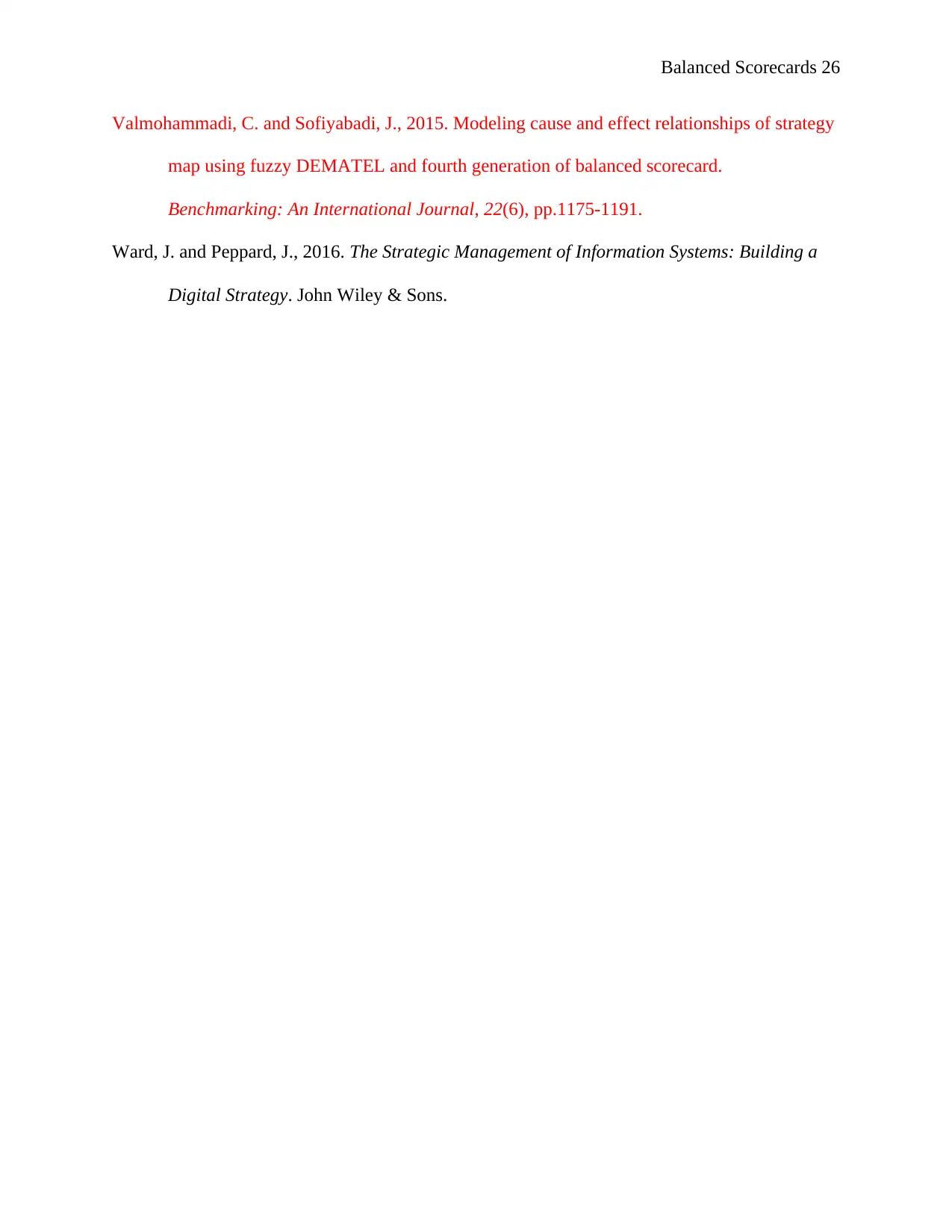
Balanced Scorecards 26
Valmohammadi, C. and Sofiyabadi, J., 2015. Modeling cause and effect relationships of strategy
map using fuzzy DEMATEL and fourth generation of balanced scorecard.
Benchmarking: An International Journal, 22(6), pp.1175-1191.
Ward, J. and Peppard, J., 2016. The Strategic Management of Information Systems: Building a
Digital Strategy. John Wiley & Sons.
Valmohammadi, C. and Sofiyabadi, J., 2015. Modeling cause and effect relationships of strategy
map using fuzzy DEMATEL and fourth generation of balanced scorecard.
Benchmarking: An International Journal, 22(6), pp.1175-1191.
Ward, J. and Peppard, J., 2016. The Strategic Management of Information Systems: Building a
Digital Strategy. John Wiley & Sons.
1 out of 26
Related Documents
Your All-in-One AI-Powered Toolkit for Academic Success.
+13062052269
info@desklib.com
Available 24*7 on WhatsApp / Email
![[object Object]](/_next/static/media/star-bottom.7253800d.svg)
Unlock your academic potential
© 2024 | Zucol Services PVT LTD | All rights reserved.





